#mount kailash 1 height
Explore tagged Tumblr posts
Text
Explore the Sacred Heights with Our Adi Kailash Tour Packages

Nestled in the majestic Himalayas, Adi Kailash, also known as Chhota Kailash, offers a spiritually enriching and adventurous experience for all travelers. Revered as a sacred pilgrimage destination, Adi Kailash is the ultimate getaway for those seeking divine blessings while soaking in the pristine beauty of the Himalayan ranges. Our Adi Kailash Tour Packages offer the perfect blend of spirituality, adventure, and cultural exploration, catering to different preferences and travel durations.
Why Choose Adi Kailash for Your Next Pilgrimage?
Spiritual Journey: Adi Kailash is regarded as a replica of Mount Kailash, the abode of Lord Shiva. Pilgrims from all over India and beyond come to this sacred site to seek blessings and enjoy the spiritual energy of the Himalayas. Scenic Trekking Experience: Along with its religious significance, the trek to Adi Kailash offers mesmerizing views of snow-clad mountains, serene valleys, and untouched nature. The journey itself is an adventure, with trails that pass through scenic villages, dense forests, and stunning lakes.
Cultural Immersion: The region is home to vibrant local cultures and ancient temples, offering travelers a chance to interact with the locals and experience their traditional way of life.
Detailed Adi Kailash Tour Packages
1. Adi Kailash Yatra – Delhi to Delhi
Duration:08 Days / 07 Nights Best Season: May to October Transport: Bus / Car (Max Or Similar) Inclusions: Guide, Yatra Permit, Pure Vegetarian Meals Cost Per Head: INR 35,000 (Discount Price: INR 32,000)
Overview:
This Adi Kailash Tour Package begins and ends in Delhi, offering a comprehensive journey to the sacred Adi Kailash. Over 11 days, you will traverse through mesmerizing landscapes, from the bustling streets of Delhi to the tranquil mountains of the Himalayas. The package includes all essential permits and guided tours to make your pilgrimage smooth and fulfilling.
Key Highlights:
Trek through scenic valleys and traditional villages.
Visit sacred spots like Parvati Lake and Gauri Kund.
Comfortable accommodation with pure vegetarian meals.
Book Now to secure your spot for just INR 32,000 and embark on an unforgettable spiritual journey!
2. Adi Kailash Trek – Kathgodam to Kathgodam
Duration: 06 Days / 05 Nights Best Season: May to October Transport: Bus / Car (Max Or Similar) Inclusions: Guide, Yatra Permit, Pure Vegetarian Meals Cost Per Head: INR 28,000
Overview:
For travelers who prefer a shorter itinerary, this Adi Kailash Trek Package starts and ends at Kathgodam. Over six days, you will experience the spiritual essence of Adi Kailash, with guided tours to all the key holy sites, including trekking routes that allow you to truly connect with nature.
Key Highlights:
Short yet enriching pilgrimage experience.
Scenic trekking routes.
Cultural experiences with local communities.
Book Now for just INR 28,000 and enjoy a hassle-free trek with experienced guides.
3. Adi Kailash Yatra – Dharchula to Dharchula
Duration: 05 Days / 04 Nights Best Season: May to October Transport: Bus / Car (Max Or Similar) Inclusions: Guide, Yatra Permit, Pure Vegetarian Meals Cost Per Head: INR 22,000
Overview:
This short but immersive Adi Kailash Yatra Package is ideal for those with limited time. Starting and ending at Dharchula, this 5-day journey offers a deep dive into the spiritual and scenic beauty of the region. Perfect for pilgrims looking for a quick yet fulfilling spiritual journey.
Key Highlights:
Ideal for short trips without missing key attractions.
Focus on sacred spots like Adi Kailash and the surrounding holy sites.
Comfortable travel arrangements.
Book Now for just INR 22,000 and join a pilgrimage that promises peace, serenity, and devotion.
4. Adi Kailash Sinla Pass Panchachuli Glacier Trek – Delhi to Delhi
Duration: 11 Days / 10 Nights Best Season: May, June, September, October Transport: Bus / Car (Max Or Similar) Inclusions: Guide, Yatra Permit, Pure Vegetarian Meals Cost Per Head: INR 45,000
Overview:
For adventure seekers and seasoned trekkers, the Adi Kailash Sinla Pass Panchachuli Glacier Trek offers an unforgettable journey through some of the most remote and stunning parts of the Himalayas. Covering the Sinla Pass and Panchachuli Glacier, this package provides an ultimate trekking experience combined with the spiritual aura of Adi Kailash.
Key Highlights:
Challenging trek suitable for experienced trekkers.
Stunning views of glaciers, snow-clad peaks, and deep valleys.
Spiritual and adventure-filled journey.
Book Now for INR 45,000 and embark on a trek that will challenge your limits and inspire your soul.
Why Choose Our Adi Kailash Tour Packages?
Expert Guidance: Our experienced guides will ensure that you experience the sacred journey safely and comfortably.
Hassle-Free Permits: We take care of all Yatra permits, so you can focus on your spiritual adventure.
Comfortable Accommodations: Stay in handpicked guesthouses or camps that offer a mix of comfort and authenticity.
Pure Vegetarian Meals: Enjoy healthy and delicious vegetarian meals, keeping your diet pure throughout the journey.
Best Time to Visit Adi Kailash
The best season to visit Adi Kailash is from May to October, as the weather is pleasant, and the trekking routes are clear of snow. During these months, you can witness the stunning beauty of the Himalayas, blooming wildflowers, and lush green valleys.
Book Now and get ready to explore the divine heights of Adi Kailash!
FAQs
What is the best time to visit Adi Kailash?
What is included in the Adi Kailash Tour Packages?
How physically demanding is the Adi Kailash trek?
Do I need special permits for the Adi Kailash Yatra?
0 notes
Text
Manimahesh Trek: Measuring the Miles To Spiritual Heights
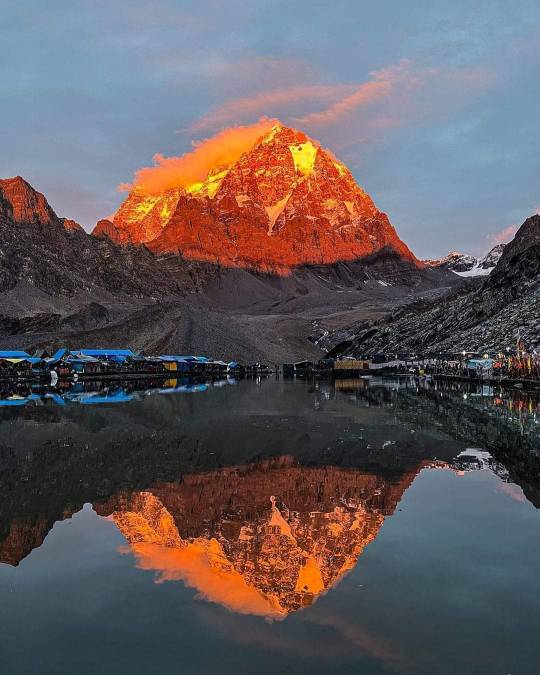
The Manimahesh Trek is a captivating journey that combines spiritual significance with breathtaking natural beauty in the heart of Himachal Pradesh, India. This renowned pilgrimage and adventure trail winds through the majestic Dhauladhar range of the Himalayas, challenging trekkers with its rugged terrain and rewarding them with awe-inspiring vistas. The trek's ultimate destination is the sacred Manimahesh Lake, nestled at an altitude of 4,080 meters (13,390 feet) and overlooked by the imposing Mount Kailash, believed to be the abode of Lord Shiva.
For both seasoned hikers and spiritual seekers, understanding the Manimahesh Trek distance is crucial for proper preparation and a successful journey. This trek isn't just about covering ground; it's an expedition that tests physical endurance, mental fortitude, and offers profound spiritual experiences. From the historic town of Bharmour to the final ascent to the glacial lake, each kilometer of this trek tells a story of natural wonder and cultural heritage.
Manimahesh Lake, at the base of Mount Chamba Kailash (5,775m), is said to be the abode of Lord Shiva. Traditionally, pilgrims used to start from the Lakshminarayan Temple at Chamba (996m) and covered the 87-km route in seven stages, on foot. Now, most take a bus or taxi ride up to Hadsar. You can stay overnight at Bharmour (65 km from Chamba) and taxi up to Hadsar the next morning to start your trek.

How Long is the Manimahesh Trek? The total distance of the Manimahesh Trek varies depending on the route you choose and your starting point. The most common route begins in the town of Bharmour and ends at Manimahesh Lake. Here's a breakdown of the distances:
Bharmour to Hadsar: 14 kilometers (8.7 miles)
Hadsar to Dhanchho: 6 kilometers (3.7 miles)
Dhanchho to Manimahesh Lake: 7 kilometers (4.3 miles)
The total distance from Bharmour to Manimahesh Lake is approximately 27 kilometers (16.8 miles) one way. This means the complete round trip covers about 54 kilometers (33.6 miles).
Breaking Down the Trek Stages
Let's take a closer look at each stage of the trek:
Bharmour to Hadsar
Distance: 14 kilometers (8.7 miles)
Travel method: Usually done by road
Time: About 1-2 hours by car or bus
Bharmour is the starting point for most trekkers. It's a historic town with ancient temples and serves as a base for preparations. The journey to Hadsar is typically done by vehicle, as it's a well-connected road.
Hadsar to Dhanchho
Distance: 6 kilometers (3.7 miles)
Elevation gain: About 1,000 meters (3,280 feet)
Time: 3-4 hours of trekking
This is where the actual trekking begins. The trail from Hadsar to Dhanchho is moderately difficult and takes you through beautiful forests and alongside mountain streams. Dhanchho serves as a popular camping spot for trekkers.
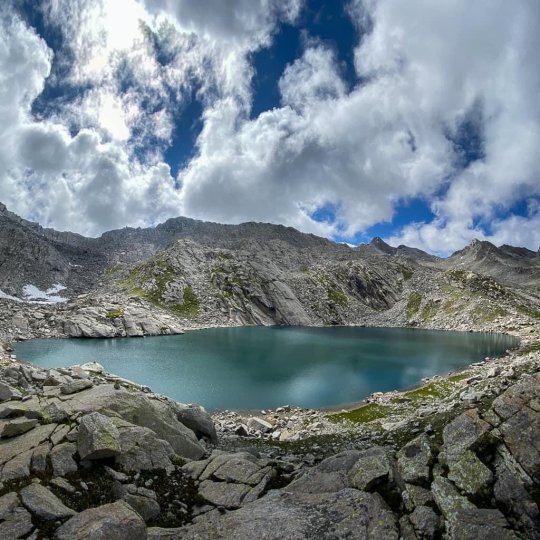
Dhanchho to Manimahesh Lake
Distance: 7 kilometers (4.3 miles)
Elevation gain: About 1,200 meters (3,937 feet)
Time: 4-6 hours of trekking
This is the most challenging part of the trek. The trail becomes steeper, and the air gets thinner as you gain altitude. However, the breathtaking views of the surrounding peaks make it worth the effort.
Factors Affecting Trek Distance and Duration
Several factors can impact the actual distance you cover and the time it takes to complete the Manimahesh Trek:
Physical fitness: Your fitness level plays a crucial role in how quickly you can cover the distance.
Acclimatization: Proper acclimatization is essential as you gain altitude. This might require additional rest days, increasing the overall duration.
Weather conditions: Rain, snow, or difficult weather can slow your progress and potentially increase the perceived distance.
Crowd during peak season: During the annual Manimahesh Yatra, the trails can get crowded, potentially slowing your pace.
Chosen route: Some trekkers opt for alternative routes, which may increase or decrease the total distance.
Tips for Managing the Manimahesh Trek
Train before the trek: Build your stamina and strength with regular exercise and practice hikes.
Take it slow: Don't rush through the trek. Maintain a steady pace to conserve energy.
Stay hydrated: Drink plenty of water to avoid altitude sickness and fatigue.
Use proper gear: Invest in good quality trekking shoes and clothing to make the journey more comfortable.
Plan rest stops: Schedule regular breaks to catch your breath and enjoy the scenery.
Consider hiring a guide: Local guides can help you navigate the best routes and manage your pace.
Alternative Routes and Their Distances
While the Bharmour-Hadsar-Dhanchho-Manimahesh Lake route is the most common, there are alternative paths you can consider:
Kugti Pass Route
Total distance: Approximately 60 kilometers (37.3 miles)
Duration: 6-7 days
Difficulty: Challenging
This route starts from the village of Kugti and involves crossing the Kugti Pass at 5,040 meters (16,535 feet). It's a more difficult route but offers stunning views and a unique trekking experience.
Karwarsi-Manimahesh Route
Total distance: Approximately 35 kilometers (21.7 miles)
Duration: 3-4 days
Difficulty: Moderate to challenging
This lesser-known route starts from Karwarsi village and joins the main trail at Dhanchho. It's slightly longer but less crowded than the traditional route.
Best Time to Trek and Its Impact on Distance
The best time for the Manimahesh Trek is from June to October. Here's how different months can affect your trekking distance and experience:
June-July (Early Season)
Pros: Less crowded, lush green landscapes
Cons: Possibility of rain, some snow on higher reaches
August-September (Peak Season)
Pros: Clear weather, best time for views
Cons: Very crowded during Manimahesh Yatra (August-September)
October (Late Season)
Pros: Clear skies, fewer crowds
Cons: Colder temperatures, possibility of early snowfall
The weather and seasonal conditions can make the trek feel longer or shorter. For instance, trudging through snow might make a 7-kilometer stretch feel much longer than walking on a clear trail.
Importance of Acclimatization
Given the significant altitude gain during the Manimahesh Trek, proper acclimatization is crucial. This process might add to your overall journey time but is essential for a safe trek. Here's a suggested acclimatization schedule:
Day 1: Arrive in Bharmour (2,195 meters / 7,201 feet) Day 2: Drive to Hadsar (2,700 meters / 8,858 feet) and trek to Dhanchho (3,100 meters / 10,170 feet) Day 3: Acclimatization day in Dhanchho with a short hike Day 4: Trek to Manimahesh Lake (4,080 meters / 13,385 feet) and return to Dhanchho Day 5: Trek back to Hadsar and drive to Bharmour
This schedule adds an extra day for acclimatization but significantly reduces the risk of altitude sickness.
Conclusion
The Manimahesh Trek distance of approximately 27 kilometers (16.8 miles) one way offers a challenging yet rewarding experience for trekkers and pilgrims alike. From the historic town of Bharmour to the sacred Manimahesh Lake, each step of this journey presents breathtaking views and spiritual significance.
While the distance might seem daunting at first, breaking it down into manageable stages makes it more accessible. Remember that the trek is not just about covering distance, but also about the experience, the stunning landscapes, and the sense of accomplishment you feel at the end.
Whether you're a seasoned trekker or a first-timer, proper preparation, respect for the mountains, and a positive attitude will help you conquer the Manimahesh Lake Trek. So lace up your boots, pack your bags, and get ready for an unforgettable adventure in the heart of the Himalayas!
0 notes
Text
Ml analysis: Native American miracle box
While is it obvious that the new miracle box is of native American origin I still went to do some research on it to see if I can narrow it down to a certain tribe and find more connections hidden in the lore.
So not to waste any time, here is my result:
The native American miracle box is in possession of the Souix Lakota tribe. Just like with the Ml Tibetan guardian monks represent not only 1 but 4 groups, the native American Miraculous tribe is a combination of the Lakota, Dakota and Nakota and where we can safely say that the monks will primarily lean towards the Tibet representation, I would say here we will primarily lean towards the Lakota. Therefore, I will call the native America Miraculous tribe Lakota but know that the other two tribes are included in this as well.
So a dead giveaway for the identity of the ml Tribe is Jessicas Shirt. In general Jessica has the hairstyle, the physical features and the accessories typical for representing an “Indian” character and her shirt is a direct confirmation of that heritage.

On her shirt is an obvious reference to the Lakota flag which pretty much tells us that this is the Tribe we are dealing with. Nice, why cant it always be this easy?
Under the cut I cover three more points to go into more detail, read more if you’re interested ^^
1. The medicine wheel
I must give it to miraculous, using the medicine wheel for the upper layer of the miracle box is one genius move imo.

The Medicine Wheel is a sacred symbol and way of life used by the indigenous Plains tribes to represent all knowledge of the universe. Unfortunately, I don’t have enough time to really get into its teaching and living ways to be comfortable explaining its practice in more details, so in this part I want to cover only what has been directly acknowledged by Thomas Astruc. And that would be the animals (duh, obviously) and the elements.
The first thing I had to learn the hard way in this research is that there is not one "true" way for this symbol to be arranged. The way its used, what animal belongs to which color or element and even what KIND of animal is in it can vary STRONGLY from location to location.
So I accepted that the arrangement can not be pinpointed down to perfect accuracy through research. We were already given all the animals and colors, now all I can really do here is present to you a possible variation of the miraculous arrangement I put together after looking up and trying to understand the differences between the real life ones to continue from here on.
There are only two animals we know for sure the connected color of: The eagle, Jessicas miraculous of freedom and the Thunderbird. In his tweets Thomas mentioned the elements so I decided to include them in the arrangement, how or if they will be incorporated into the show I can not tell you though. But still I wanted the elements in here as well ^^
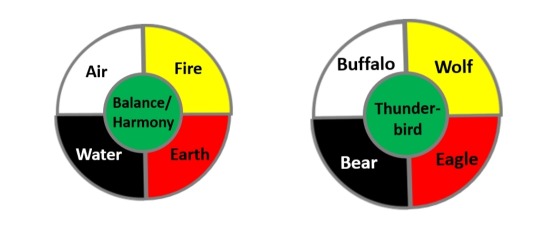
As already said, the eagle is red and the thunderbird is in the green center. As you can see I put the bear to black, the Wolf to yellow and the Buffalo to white. Those seemed to me the most likely combinations and even if they don’t end up right, it wont do harm to any of this.
Buffalo: white and air because the Lakota have a white Buffalo woman legend where air was one of the main elements she controled and used.
Wolf: yellow and fire. Fire because in Lakota legends the wolf/ coyote is a very unpredictable animal. He's both a trickster and a hero, not always moraly sound but always clever. It's a dangerous but strong and lively nature that I do think the show could represent with the fire element. Yellow is one of the two cases where I was left with this option by default.
Bear: I choose black and water because that's a combination I have seen the most
Eagle: I already know Red and choose earth in combination. At first I thought about putting fire in this place because of its normal association with red but in the end choose earth because I think it's the element that fits the best to Jessica.
But the reason why I decided to include the elements is because of the green thunderbird in the middle. Because where the other 4 animals are connected with the 4 elements, the thunderbird would here represent inner balance and harmony. Of course this isn't it's power, but the layout makes it quite obvious that the thunderbird is the equivalent of the ladybugs and cats yin-yang. My assumption right now is that this is how the show will cover the different types of "balance" although the world cultures it incorporates, but let me come back to this one another time.
2. more cultural references and meanings
The thunderbird represents the most powerful one of this miracle box because the thunderbird is the one animal that is present in every Souix Lakota tribe and holds an enormous cultural and spiritual significance. It is a mythological bird and is associated with several legends starting from controlling the storms, lightnings and thunder to being the protector of the humans and even being a helper of the creation of reality (Reality in Ml are the LB and Cat hence why its place in the middle of the box is well deserved) It only makes sense that it would be chosen for this and I know it may seem cliché but please hear me out, which is why im convinced this is the miraculous of the chiefs.
A couple of details do support this for me but please remember I'm not exposed to alot of native American cultures I'll do my best to get things right but if I do interpret something(s) wrong feel free to correct me.
For one, well, the symbol. While looking up the clothing for a later point I did see a symbol like this on some of the feather headdresses.

Definitely not on all of them, I couldn't figure out if there is a system behind the pattern usage or tied to a distinct area but I do know that it is THERE and not exactly rarely either. Noticeably it isn't a 1 to 1 fit but that is an all time returning thing in miraculous. Real life and historical things like this have to be slightly altered for the show to be able to incorporate them. A great example for this is the old English flag in "Darkblade".

So at this point I'm used to this pattern, so yeah, this could very likely be a symbol they took inspiration from.
The second reason why I think it it's the miraculous of the chiefs is because the piece with the symbol on it looks like one of these
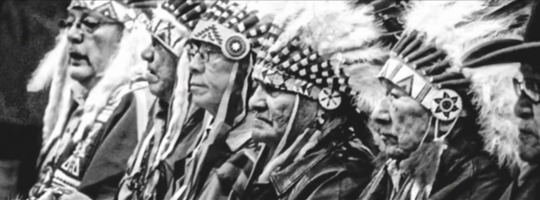
In combination with the feather on it. The feather headdress is also called a war bonnet and was originally only worn in battles and only by the person who has truly earned that honor. Each feather represents a distinct honor earned in battle which is why we see feather headdresses in such different lengths. How this translates perfectly into a miraculous I think is obvious. The headdress is a symbol of true leadership and worthiness of such a status, hence why it were especially the chiefs to earn such impressive ones. Turning it into a miraculous wouldn't change too much about it since such a powerful miraculous is an honor and duty you have to be worthy of as well. Them being originally used only for battles is a perfect fit too, because so are the miraculous.
Then of course once again, the thunderbird.
The thunderbird being the great mythical protector animal of these tribes makes it naturally a perfect fit for the miraculous animal of the great chiefs. The chiefs were not only the leaders they also were the primary warrior in battles which is seen by the war bonnets. Having the Thunderbird be the miraculous of the chiefs highlights their status as the tribes protector in such a genuine way, I personally really really love it.
As the last point of 2. I want to bring up the outside top of the Miracle box and the way its designed. While looking through the clothing symbols and pattern I did notice some that looked similar to the ones on the box. I deliberately tried to find a more recent example of usage because in the end of the day Miraculous is a show for TODAY so if the show used patterns for example that may not have been used in the past but are now associated with the Lakota that’s still valid. So the possible matches for design inspiration I found stem from a picture of chief Arvol Lookinghorse who holds the responsibility of spiritual leader among the Lakota, Dakota and Nakota People to this day.

3. Their location and monuments
Researching the lakota made me think of where this guardian group has its roots, which made me remember something I found on my guardian mountain - mount kailash theory a while ago (I swear right now everything comes back to that theory). In it I showed you the monuments-line around the world always separated by a length of 6666km between each other (basically the height of Mount Kailash) and while I didn't mention it there, there is also one of those "mythical" monuments in the USA.
The bears lodge butte (in Wyoming)

I mean LOOK at this, that is out of this world and breath-taking in every sense of the word! That is a location of a miraculous guardianship if I had ever seen one. Also known under the (sadly) much more well known name of "Devils tower" but this will be the one and only time you will read of me calling it like that. The fact that this butte is still officially called by this disrespectful and bastardized white peoples name is a freaking insult. I'm calling it the bears lodge as this was its original english name.
The bears lodge is not just a monument in the USA it is the VERY FIRST official monument (1906) and the location of the butte also checks out perfectly with the areas the Lakota settled in real life. I couldn’t get the exact scale but I think you will still understand just fine.

Adding to the Bears Lodge butte I also wanna bring up the "other" medicine wheel. Which is, just like Bears lodge, located in Wyoming.

As we know the rest of the native American miracle box is made of the zodiac signs just like in our normal miracle box. Confirmed not only on Twitter but also in the very intro of the New York special.


But the same way the miracle box is similar to ours the Medicine wheel as monument reminded me of something as well. Of course I'm talking about the ritual circle in the Kwami "dimension" of the box seen in “Sandboy”.
And just like the native American monument it is also of "astronomical" nature. Taking a closer look at the Chinese Kwami circle one can see that the outer ring is made of specific places for each Kwami signified with a picture of their "animal".


And in the inner circle is obviously the moon circulation.
Meaning, put very simple, this is a design specifically meant to represent the Chinese calendar and culture this miracle box is based on. Therefor this should also exist for the native american one. My guess Is that for all the boxes/cultures Miraculous is gonna include they will also have an “ritual circle” equivalents for each based on all the different kinds of stone circle monuments around the world, including the medicine wheel of the Lakota.
But not only was the medicine wheel monument used for astronomical purposes, with it the people wanted to give things back to mother nature. They placed things right in the middle of the wheel under the stones so nature could take it back "spiritually" (for a lack of a better word on my part) through their rituals and chants. Which is something once again similar to what we see with the Kwamis.
First if all, when the Kwamis (who are the embodiments of the abstract concepts reality is made of) enter their "dimension" in the miracle box the guardian symbol opens right at the center point, letting them cross the layers of reality.

Second, the Kwamis are obviously able to take material objects with them to the in-between dimension. Supporting and verifying the Lakota’s ritual because at the very least in the ML world its actually true. And thirdly, when the Kwamis try to reach Nooroo they chant as well and once again the collected energy is combined in the middle to cross the layers of reality. Gabriel is transformed though so he, as Hawkmoth, is able to almost take over the connection and therefore the miracle box if the Kwamis hadn’t blocked him.

This shows that the spiritual dimension layers are interactive from both sides under certain circumstances. A normal human being wouldn’t be able to cross the layers and take control like this but the more a person is involved with/ powered up by the miraculous the more power they hold interdimensional. Which is the idea of a ritual to reach the spiritual side of nature brought to a new 11 as TV shows usually do.
4. The design of the guardian.
I'm definitely not the right person to properly judge this in depth therefore I will just showcase my opinion based on the research.

The way I see it for the guardians design they tried to combine the guardian "look" with the native American one.
The pants, staff and robe-like upper part are obviously influenced by the guardian we already saw through Fu's flashbacks, whereas the colors, the hairstyle and shoes (etc) are kept more Lakota-like. Though, as far as my opinion counts in this, the much darker skin and the eyebrows in comparison to Jessica does make me question if he is supposed to represent the same native American tribes as her. His bushy eyebrows are a physical characteristic I recognize in rarely any real life photos and neither did I notice such a noticeable difference in skin color.

Jessica and the guardian simply do not really look like they are of the same heritage to me, but again, who am I to say this isn't a legit representation? Besides that, it makes alot more sense that this guardian wasn't lost for almost 200 years like the ones in Tibet, so it is a fair option to consider that this black guardian may not be of "original Lakota heritage" but he is simply a worthy man born in this area of the USA (who knows in what year considering the guardians life spans) who was chosen and trained for the guardianship simply because he was the right fit for it just like Marinette.
I think it's only fair to consider that option as well, especially since we have NO official background on him. But that's just my opinion.
And as the last thing I want to bring up is the symbol on his robe because this is something I'm going to need help with.

We can hardly see it and I've tried my best to find something in my research but I just couldn't find anything fitting.
If anybody has the means and knows if this is a cultural reference as well, I would appreciate it if this knowledge could be shared here as well. I really would love to know ^^
#miraculous#miraculous ladybug#ml spoilers#ml theory#ml new york special#ml new york spoilers#Native american miraculous#Lakota tribe in Ml#ml sugar#Miraculous world#Miracle box#ml sandboy#thomas astruc tweet#guardians of the miraculous#Jessica Keynes
218 notes
·
View notes
Text
10 Places With The Strongest Energy Field
Many people who are either outdoor enthusiasts, or just generally spiritual people seek their spiritual experiences in nature. Across the world, there are various destinations that contain spiritual significance that is both sacred and spiritual places in nature. With thousands of years of spiritual history, these places can provide answers and enrichment on our paths to enlightenment, as well as provide concentrated energy that will bring you to new heights in your spiritual path.
These are the top 10 spiritual places found in the world that are worth visiting, regardless of your religion or spiritual views.
1. Machu Picchu, Peru

It has been said that the sacred city of the Incas is magical, and this is indeed very true. Built high in the Andes, this particular place is one of the “Seven Wonders of the World”, and boasts of amazing scenery and stone monoliths that will leave you in awe of its energetic qualities. It seems that this place itself channels massive amounts of energy and allows people to experience something that is out of this world.
2. Crater Lake, Oregon

Claimed to be a major intersection of the Earth’s global grid, it is said that healing clay can be found there. Not only that, but there are several powerful vortexes that are claimed to still exist around Crater Lake. This area was formed 8,000 years ago after a massage eruption led to Mount Mazama collapsing. Plunging nearly 2000 feet below ground, this lake is the deepest in the US and the seventh deepest in the world.
The Native American Klamath tribe has always found this lake to be a spiritual and sacred site. One legend says that the Chief of the Above World and the Chief of the Below World battled against one another, leading to the destruction of Mount Mazama. Long ago, tribesman would use Crater Lake for vision questing. This area is still considered a highly spiritual spot. As a part of Crater Lake National Park, as well as a part of spiritual history rich with potential for the experience of a lifetime, consider making this a list topper on your places to see list!
3. Easter Island, Chile

Easter Island, Chili is a highly isolated location and is not very well known to the general public. However, it is the home to some very massive statues, which interestingly enough cannot be linked to any particular creator. Scientists have absolutely no idea of how exactly they originated. The mysterious qualities of the island don’t stop there either. There are 53 stone houses which form an uninhabited village. There are no windows or doors in any of these homes. The big mystery concerning this island, though, is the “Navel of the World”. This is a circular stone that many believe holds the secrets of the universe as it supposedly collects most of the spiritual energy lines of our planet.
4. Mount Kailash, Tibet

Located in the North of the Himalayas, Tibet, this fascinating mountain is the spiritual center of four great eastern religions: Tibetan Buddism, Hinduism, Jainism and the ancient Tibetan religion that came before Buddhism-Bongo.
Many people have traveled from around the world to this mountain, and currently, a growing number of people believe that Mount Kailash is the energy center of the Earth. It is always a popular belief that the entrance to the Forbidden City-Shambhala- is located near the mountain. Going on a pilgrimage around Mount Kailash, and swimming in Lake Manasarovar, also located near Kailash, are considered spiritual experiences that encourage redemption while washing away the sins we have committed during our lifetime.
5. Rila, Bulgaria

People have referred to Rila Mountain as the Nose of the Earth, due to the fact that it stood above everything else without submerging into water. Although things have changed today, this mountain still stands close to the heavens and has managed to preserve some of the most impressive miracles found in this spiritual epicenter, namely the beautiful Seven Rila Lakes and the mesmerizing Stob pyramids.
The former boasts powers of spiritual cleansing by thousands of people each year, while the latter serves as natural anthology rich in ancient myths and legends.
6. Sedona, Arizona

Not only is Sedona beautiful and serene, it has long been considered a spiritual power center. The power and energy that emanates from the vortexes found in Sedona are unmatched. The energy that is found in Sedona is the main reason for the large New Age community that has begun to grow in the area. These communities, which hold a variety of spiritual beliefs, practices, and healing modalities are the reason Sedona is often referred to as a spiritual Disneyland.
Anyone who has a sensitivity to subtle energies would be overwhelmed with the experience of standing in one of these vortices, as the energy that flows through you can be intense. People from around the world come to Sedona to experience this.
7. Socotra Archipelago

Socotra is an archipelago of four islands in the Indian Ocean to the Horn of Africa. The largest island occupies about 95% of the total area. Many species that are found in this regions are specific to this region only, due to isolation. The majestic landscapes make this area appear to have come straight from a science fiction movie.
When you are in this area, the appearance and feel can make it seems as though you have slipped into another dimension. You can be connected directly to the cosmos through the energy channeled in this spiritual minefield.
8. Stonehenge, UK

Stonehenge lies silhouetted against the skyline and overlooking the windswept Salisbury Plain. In the past centuries, as well as today, many theories have been provided in an attempt to explain the existence of this stone temple. However, the reason remains a mystery.
Stonehenge is world famous for its spectacular solar alignment that can be seen at the summer solstice on June 21st. The midsummer sun is seen rising over the Heel Stone from the center, causing thousands of people to gather at the monument each year to experience this majestic sight. Ancient people found the cycles of the Sun and the Moon to be importance, and they revered these bodies as powerful deity that could impact their daily life. These people also found areas of the Earth as massive energy portals and vortexes and used them to build statues, monuments, and temples which helped them connect more powerfully to their own spirituality.
9. Bosnian Pyramids, Bosnia

Based on carbon analysis, it has been found that these pyramids have been around since before the Neolithic period. This would make them over 12,000 years old, or older than the Egyptian pyramids, which seem to be more commonly well-known. The lake which is found below it is beautiful, blue, and clear of any negative presence. This water is referred to as living water because it is said that it purifies the body. Rooms are also found below it which are underground, and known as the “healing rooms”. Many say that these rooms cause the human body to regenerate faster, causing quicker healing to take place in the body.
10. The Plateau Uluru, Australia

As Australia’s spiritual center, this place is located right in the middle of the continent. Many locals, as well as tourists, say that you can feel the energy emanating in the area quickly upon arrival. A hollow plateau faces you and is locally referred to as Tiukurpa, meaning Dreamtime. Spiritual visions can be common while you are in the Uluru Plateau.
Modern life can be very chaotic, and it becomes impossible to sit back and seek solace in the realms of our own mind and soul. These experiences not only center us while relieving stress, but also push us in a more spiritual direction where we can access inner peace, gratitude, forgiveness, and much more enlightenment. Visiting any of these places that are rich in spirituality and organic energetic fields is a great way to step back and find your own true spiritual awakening.
13 notes
·
View notes
Text
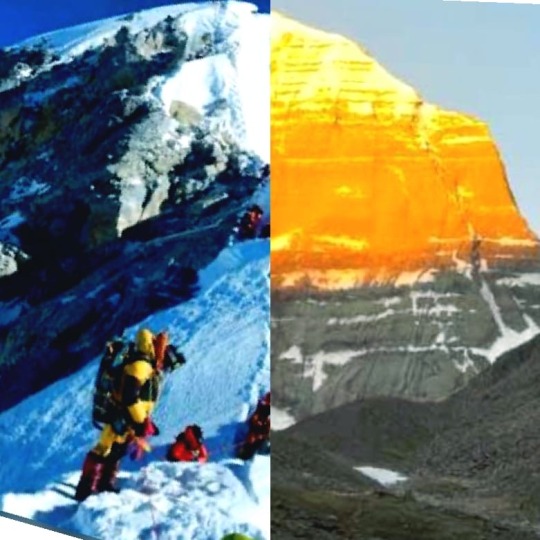
DO YOU KNOW...
.
.
1. HEIGHT 8848 METERS MORE THEN 4000 PEOPLE HAVE SUCCESSFULLY CLIMBED MOUNT EVEREST.
2. HEIGHT 6638 METERS EVEN AFTER MANY EFFORTS TILL DATE NO HUMAN HAS CLIMBED MOUNT KAILASH.
#Height #meters #successfully #climbed #mounteverest #human #climbed #mountKailash #life #love #unknownfactsbyjoshi
0 notes
Text
Secrets of Mount Kailash will surprise you
Secrets of Mount Kailash will surprise you
Kailash Mansarovar is located near Mount Kailash, the abode of Lord Shankar. This amazing place is full of mysteries. Shivapuran, Skanda Purana, Matsya Puranaetc. have a different chapter called Kailash Khand, where the glory is praised.According to mythological beliefs, this is the city of Kubera. It is from here that the Ganges falls out of Mahavishnu’s curbs and falls on the top of Mount…
View On WordPress
0 notes
Text
Top 12 Jyotirlingas-Temple of Lord Shiva In India
India is known as the pilgrimage because here, the supreme being, the Hindu deity—Mahadev-the destroyer of evil has left his imprints throughout the country in a form of 12 Jyotirlingas. Many of you must have heard the stories of Shiva Purana while growing up, but have you ever come up with what Jyotirlingas mean are. Indian Visa helps you to find hassle free Indian E Visa. Jyotirlingas—are the shrine of Lord Shiva. People worship him in this form because it is believed that there is no form of cosmic energy—he is who, has form and he is who, has no form. The Jyotirlingas also means as the radiant sign (phallus symbol) of the Almighty. It has another meaning as well- ‘Jyoti’ means light and ‘linga’ means sign, thus Jyotirlinga is the light of Shiva.
However, if you are a peace seeker, spiritual and calm finder and want to get rid of problems, then you must visit on these 12 Jyotirlingas. Here are the complete details so that you can travel to witness the positive and cosmic energy by your own eye-
1. Somnath Jyotirlinga, Gujrat
This holy temple is considered one of the first Jyotirlingas among 12. Somnath Temple is situated in Gujrat near Veraval Kathiawad district (Prabhas Kshetra). It is a highly revered pilgrimage throughout the whole country. People fly across the country to witness this holy place. However, according to the Shiva Purana, once the moon was cursed by Prajapati Daksh, who married his 27 daughters, but moon loved Rohini the most, when Prajapati Daksh enlightened with the information, Daksh cursed the moon that he would lose all his radiance. As a result, the moon began to lose his celestial being, Rohini and other wives of moon requested Lord Shiva. Lord Shiva then, assumed moon in his matted locks and blessed him with new life and called Somchandra or Somnath.
2. Mallikarjuna Jyotirlinga, Andhra Pradesh
The second Jyotirlinga named Mallikarjuna is situated on the top of Shri Shaila Mountain, near the bank of Krishna River in Andhra Pradesh. It is known as the ‘Kailash of the South’ and one of the most visited Shaivite shrines in India. According to Shiva Purana, Lord Ganesha's marriage was going to called-off because Kartikeya is the eldest and he should have to marry first, to resolve this issue, Kartikeya left Kailash and went to the Kraunch Mountain. The gods went there to console him, but he refused to come so ultimately Lord Shiva and Parvati reached to let him aware of the events of Kailash, in the meantime, Kartikeya got consoled, and he understood the situation that because of him Ganesha denied to marry and he then ready to go back. Thus, this made Shiva install Jyotirlinga named Mallikarjuna. It is believed that, if a person is just seeing this mountain tip, is get rids all the problems of life and become free from all the sins and life and death cycle.
3. Mahakaleshwar Jyotirlinga, Madhya Pradesh
This temple is situated near the bank of the Kshipra River, in Mahakal forest in Ujjain. There are so many telling and retellings of how this Jyotirlinga came to existence. According to Shiva Purana, there was a boy named Shrikar, who took a stone and begun worshipping as Shiva. Many villagers tried to dissuade him variously but he didn’t stop. And, Shrikar’s devotion kept growing. The pure devotion and dedication pleased Mahadev. Lord Shiva came to bless him with boon and assumed the form of a Jyotirlinga in the Mahakal forest. However, it is also known as amongst the one of the seven ‘Mukti-Sthal’-a place that liberates a human from life and death cycle.
4. Omkareshwar Jyotirlinga, Madhya Pradesh
It is believed that once Bindhyachanl parvat (mountain) wanted to become the biggest mountain, in his vain. To fulfil this, he began to worship Lord Brahma to get the boon. After some time, he used his boon to placed himself as the biggest parvat, as a result, he was so heavy and Goddess Prithvi even couldn’t handle his weight. Thus, the Goddess and other deity prayed Lord Shiva to made Bindhyachal parvat release his mistake. When Bhindhya realized his mistake, he asked Shiva to place a Jyotirlinga over there. Thus, he emerged in a form of Omkareshwar Jyotirlinga. However, it is one of the most sacred pilgrimages, which is situated on an island named Shivapuri, near the Narmada River.
5. Vaidyanath Jyotirlinga, Jharkhand
This holy temple is also known as Baidyanath or Vaijnath, located at Deogarh, Santal Paranas region of Jharkhand. According to the ancient scriptures, once Demon King Ravana worshiped Shiva and tried to take Mount Kailash with him, but Shiva crushed his effort and then, Ravana asked Lord Shiva to come with him to Sri Lanka and reside there forever. On this situated, he made Ravana to give a promise to him that on the journey of Sri Lanka, he would not put the linga on earth, if it is done, then Lord Shiva would be placed there forever. On the journey of Sri Lanka, Lord Varuna entered into the body of Ravana and as a result, he needed to put the linga on the earth, but then, he found a child named Vaidya (Lord Ganesh). Ravana put the linga on Vaidya’s hand and went to relieve himself. Vaidya put the linga on the earth, thus it came to be known as Vaidyanath.
6. Bhimashankar Jyotirlinga, Maharashtra
The Bhimashankar temple is situated in the Sahyadri region of Pune, Maharashtra. This temple is considered one of the sacred pilgrimages. It has existed near Bhima River. As the ancient stories says—this Jyotirlinga is related to Bhima-the son of Kumbhakarna, when he learned that his father’s death is done by the incarnation of Vishnu as a Ram, he vowed to take avenge. He did many penances to achieve power. Once he received power, he then began to create havoc in the whole world. Bhima then defeated Lord Shiva’s devotee-Kamrupeshwar and put him in the dungeons. This angered Lord Shiva. The war began between Bhima and Lord Shiva. Thereafter, Bhima got defeated. On the request of Gods, Shiva manifested himself in the form of Bhimashankar. If you want easily Urgent Indian Visa and Indian E Visa then you have to apply through Indian E Visa
7. Rameshwaram Jyotirlinga
Rameshwaram Temple is situated on the island, off the Sethu coast of Tamil Nadu. It is one of the topmost pilgrimages, and its architecture is so praiseworthy by the visitors and architects. However, it is said that, when Ram was preparing to fight with Ravana, the Demon King, Ram worshiped Lord Shiva by making a linga on the seashore (after drinking water without taking permission) and seek blessings. Ram then got blessings of Lord Shiva and then went for the great battle with Ravana to rescue Sita.
8. Nageshwar Jyotirlinga, Gujarat
The Nageshwar temple is situated on the route of Gomati Dwarka and the Bait Dwarka Island, Gujarat. It is believed that, if a person worships Lord Shiva, all types of poison whether it is outer or inner, Lord Shiva protects his devotee.
According to the Shiva Purana, Supriya-a devotee of Shiva was captured by the demon Daaruka. Then, Supriya advised other devotees that they should chant ‘Om Namah Shivay’. This act enrages Daaruka and she ran to kill Supriya, thereafter, Lord Shiva came to rescue the devotees, thus, the Nageshwara Jyotirlinga came into existence.
9. Kashi Vishwanath, Varanasi
Kashi, the most sacred pilgrimage of India. It is said that this place is one of the most loveable places of Lord Shiva. This temple is situated in the Ghats of Ganga. In Manikarnika, Lord Vishnu’s earing fell, when the three deities were creating the world. Thus, to show devotion and love towards Vishnu, Lord Shiva created Manikarnika city and Kashi Vishwanath Jyotirlinga. People worship here to get Moksh, liberation, and happiness.
10. Trimbakeshwar Jyotirlinga, Maharashtra
The Trimbakeshwar Temple is located near Nasik in Maharashtra. This temple is considered to be the source of river Godavari floating, which is also known as ‘Gautami Ganga’-the sacred river in South India. According to Shiva Purana, Gautam Rishi penanced for so long and earned a boon from Varuna Dev so that he could supply water to the farm, on this act, other deities got jealous and sent a cow to destroy everything. Mistakenly, Gautam Rishi killed the cow, who then worshiped Lord Shiva to get help on how to purify the premises. Then, Shiva asked Ganga to flow on the area and make it pure. Thereafter, Lord Shiva came to earth with Ganga on his locks in the form of Trimbakeshwar Jyotirlinga. Thus, it is believed that, if anyone wishes to get something, he or she will be fulfilled with boon or desires.
11. Kedarnath Jyotirlinga, Uttarakhand
Kedarnath temple is situated on the Rudra Himalaya, at the height of 12000 feet on a mountain named Kedar. It is far around 150 miles from Hardwar. It is believed that, once there were Narayana and Nara (the incarnation of Vishnu) penanced for years on the top of Kedar mountain, Lord Shiva pleased with the penance and thus, placed a linga for desire fulfilment. However, people do visit over here to pour holy water from Yamunotri and Gangotri to please Shiva.
12. Ghrishneshwar Jyotirlinga, Aurangabad, Maharashtra
The temple Ghrishneshwar is located in the village named Verul, near Aurangabad, in Maharashtra. You can find this place very easily because the temple is near the famous tourist attraction named—Ajanta and Ellora caves. The temple was built by Ahilyabai Holkar. This temple is also known by the name of Ghushmeshwara, Kusumeshwarer, Grushmeshwara, and Grishneshwara. As per the Shiva Purana, there was a couple- named Sudeha and Sudharm resided on the Devagiri Mountain. They were childless and this made Sudeha unhappy, so she asked her sister Ghushma to marry Sudharm. Thereafter, the new couple got a son. As time fade, Sudeha got jealous of her sister. When the son of Ghushma and Sudharm became adult, they married him with a beautiful girl. On seeing this much happiness, Sudeha, got even more jealous. In jealousy, one night she killed Ghushma’s son. And, then she threw her son in the nearby lake, where Ghushma prayed to Lord Shiva every day. When Ghushma knew about the whole incident, she didn’t say anything to her sister and started praying to Shiva. On seeing Ghushma’s devotion and dedication, Lord Shiva gave her son a new life and emerged himself in the form of Ghushmeshwar Jyotirlinga. If you are an International traveler and interested to visit India then you need valid Indian Visa to enter in India.
Conclusion
In this article, we have described the 12 sacred Jyotirlinga and their positive energy into thousands of lives. However, if you want to find peace and happiness into your life, then do visit in India to witness the divine power and energy of the Jyotirlingas.
0 notes
Text
Mount Kailash Inner Parikrama
Mount Kailash Inner Parikrama
About Mount Kailash Inner Parikrama
Beside the regular Holy Mt. Kailash Yatra – Drive in/ Drive out, Fly in/ Fly out via Simikot, via Lhasa etc, Fishtail Tours has been promoting a very special program for those yatris who want to reach heart of the abode of Lord
Shiva and want to make close darshan of Astaparbat (Astapada), Nandi Parbat, Kailashi Gange Kuber Parbat, Astamatrikagan Parbat,…
View On WordPress
0 notes
Text
Distinguished Educationists and Media personalities honoured on Teacher’s Day eve
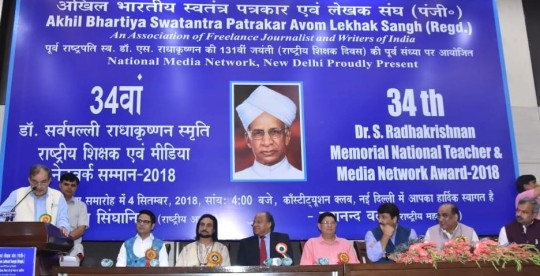
Eminent educationists and media personalities were honoured with the prestigious Dr S. Radhakrishnan Memorial National Teacher and Media Network Award- 2018 at the Constitution Club of India on 4th September’2018. The Award program organized on the eve of Teacher’s Day under the aegis of Akhil Bhartiya Swatantra Patrakar Avom Lekhak Sangh (An Association of Freelance Journalists and Writers of India) was the 34th event in succession. This year’s event coinciding with the 131st Birth Anniversary of former President of India Dr. Sarvapalli Radhakrishnan was graced by the presence of Union Minister of Steel Ch. Birender Singh who was the Chief Guest. The award function was inaugurated by Ambassador of Venezuela in India H.E Augusto Montiel and Santoor Maestro Padam Shree Pandit Bhajan Sopori.
Notable among the distinguished personalities who graced the event and honoured the awardees were Manoj Tiwari (Delhi BJP Chief and MP), Rakhi Birla (Deputy Speaker of Delhi Vidhan Sabha). Adesh Gupta (Mayor of NDMC), Dr Yoganand Shastri (Former Speaker of Delhi Vidhan Sabha), Dr Narender Nath (Former Education Minister), and Devender Yadav (AICC Secy and Co- Incharge Rajasthan).
Prem Singhania (President) and Dayanand Vats (National General Secretary), the two pillars of Akhil Bhartiya Swatantra Patrakar Avom Lekhak Sangh played the perfect hosts and the organizers.
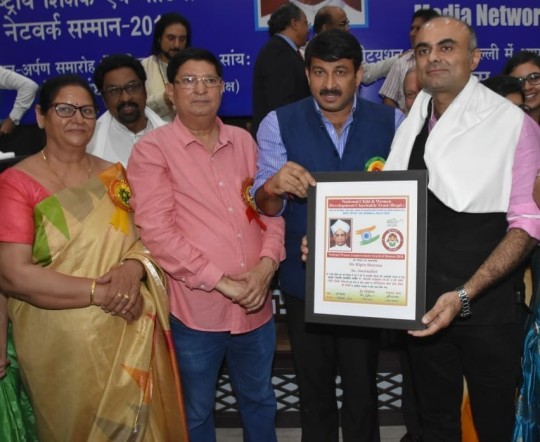
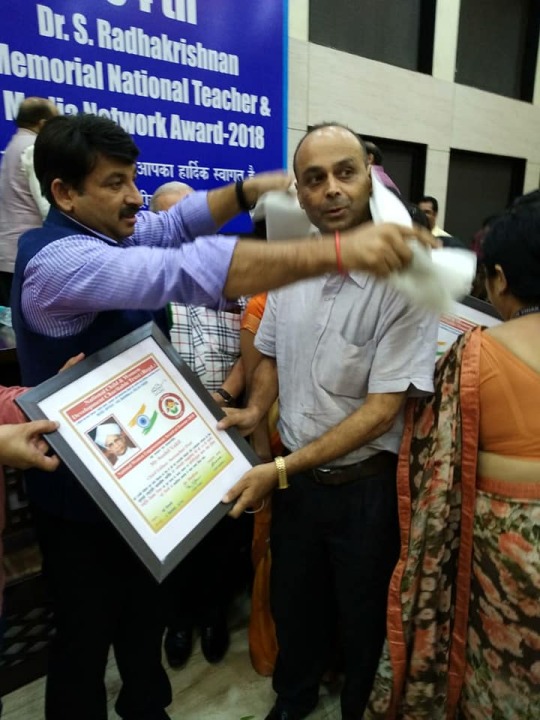
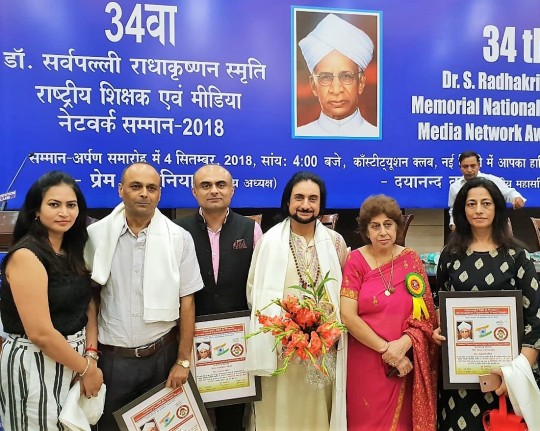
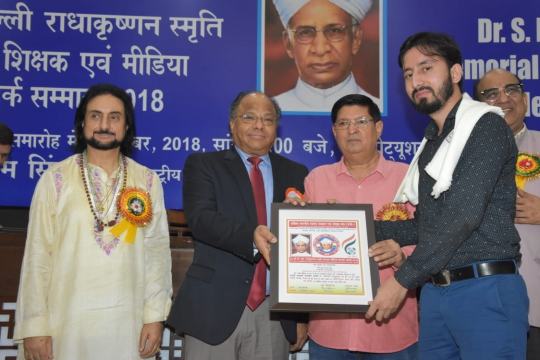
At the glittering function organized at the Constitution Club of India, educationists and media personalities who were felicitated included names like senior journalists Sushil Vakil, Bipin Sharma and Sunita Vakil, Anjeet Srivastav (Anchor, News Nation), Dinesh Kandpal (Sr Producer, India TV), Devendra Sharma (Business Editor, Rastriya Sahara), Bhawna Gulati Nayar (Sr Producer, Anchor, Lok Sabha TV), Sheerin Siddiqui (Sr Anchor, Sr Producer, India News), Puja Shukla (Sr Anchor/ Correspondent, Delhi NCR, Total TV), Saumya Pandey (Young Documentary Maker), Syed Suhail (Sr Anchor, News 24), Garima Sharma (Freelance Journalist), Sabeena Tamang Deshmukh (Sr Producer, Anchor, Reporting Manager, Zee Hindustan), Hemwati Nandan Rajoura (Sr Correspondent, Hindustan), Yogender Mann (Director, Press & information, NDMC & East MCD), Pradeep Mahajan (Chairman, INS Media), Shah Faisal (Assistant Manager, Hindustan Times & Sr Group Leader, HT Media), Dr Sorabh Malviya (Astt Prof, Makhan Lal Chaturvedi Rashtriya Patrakarita Vishwa Vidyalaya Noida Campus), Yogesh Sharma (Chief Editor, Parichay Times Hindi Daily), Rajan Sharma (Sr Correspondent, Hindustan), Pradeep Srivastava (Sr Special Correspondent &HOD, Guest Relation, NewsX, ITV Network), Narender Bhandari (Principal Editor in Chief IPPCI Media. Org.), Digpal Singh, Chief Sub Editor, Jagran.com, Anant Paliwal, Chief Copy Editor, Amar Ujala. Com, Harjeet Prakash, Chief Editor, Uday Prakash Newspaper, Sumitra Goel, Principal, J.R Media Institute, Punjab Kesari, Delhi, Vijay Sant, Crime Reporter, Good Evening Delhi, Anamika Amber, Deligate, Parliament Press of South Asia, M.P Chapter, Ravindra Kumar Tanwar (Lecturer, HOD Fine Art) Delhi Police Public School, Safdarjung Enclave, New Delhi, Pandit Vijay Shanker Mishra (Musicologist, Music Critic, Writer, Teacher), Anurag Singh ( Sangeetacharya & Musician- Vichitra Veena Player) Music Teacher, DAV Public School, Kailash Hill, New Delhi, Ghulam Abbas Khan ( Eminent Hindustani Classical Singer & Composer ), Mridu Marwah (Sr Biology Teacher, Bal Bharti Public School, Sector-10 , Rohini, Delhi), Nipun Soin ( Eminent Art Curator) Director, The Allure Art & Event, New Delhi, Dr Jaswinder Singh (Principal) SGTB Khalsa College, Delhi University, Dr Swati Pal (Principal) Janki Devi Memorial College, Delhi University, Dr Manoj Sinha (Principal) Arya Bhatt College, Delhi University, Prof Hansraj Suman, Member Academic Council, Delhi University, Vandana Jha (Principal) Neo Great Mission Public School, Sector-5, Dwarka, New Delhi, Dr Deepika Sharma, (Lecturer) Great Mission Teacher’s Training Institute, Sector- 5, Dwarka, New Delhi, Tushar Mittal (TGT. Work Exp) Kendriya Vidyalaya N.2, APS Colony, Delhi Cantt, New Delhi, Sunita (Lecturer History) Joga Singh Khalsa Girls SSS East Patel Nagar, New Delhi, Arjun Singh (TGT Math) Mount Abu Public School, Sector-5, Rohini, Delhi, Dr Vivek Gautam (Lecturer English) Govr Co-Ed SSS Chilla Village, Mayur Vihar-Ph-1,Delhi, Seema Malhotra (Principal) Manav Rachna International School , Faridabad, Haryana, Gyan Sagar Mishra (Lecturer History) School of Excellence, Sector-17, Rohini, Delhi, Dr Jyotsna Sharma (Principal) Shambhu Dayal Global School, Dayanand Nagar, Ghaziabad, UP, Bimlesh Jha (Principal) DAV Centenary Public School, Narela, Delhi, Geoff Lyonel Jonathan (CEO) Apex Public School, Sant Nagar, Burari, Dr Nicky Dabas (Founder President, Nutrition & Natural Health Sciences Association, Delhi), Dr Deepali Bhalla, Manager, Little Flowers Puhlic School, Vijay Park, Yamuna Vihar, Delhi, Bhavna Arora (HOD, Social Science) Little Flowers International School, 100 ft Road, Shahdara, Delhi, Shanta (PRT) SLS DAV Public School, Mausam Vihar, Delhi, Payal Ahuja ( PRT Science) SLS DAV Public School, Mausam Vihar, Delhi, Harpreet Kaur Chera, Asst Teacher, Bosco Public School, Sunder Vihar, New Delhi, Vibha Khosla, Principal, Shri Ram School Delhi West, Tikri Kalan, Delhi, Bhavna Sawnani, Mentor Teacher, TGT Natural Sciences, RPVV, Thyagraj Nagar, New Delhi, Kiran Khullar, Supervisory Head, DAV Public School, Phase 4, Ashok Vihar, Delhi, Hemant Kumar Jha, Principal, Aryans International School, Buddhi Vihar, Moradabad, U.P.
Those honoured with the 34th Dr S Radha Krishnan Memorial National Medical Teachers Awardees 2018 included stalwarts like Dr. B D Athani (Principal Consultant, DGHS, MoHFW, Professor, Physical Medicine and Rehabilitation, VMMC & Safdarjung Hospital, New Delhi), Dr. Beeva Boruah (Professor & Head, Department of Community Medicine, Fakhruddin Ali Ahmad Medical College, Barbeta, Assam), Dr Ganesh Govekar (Professor and Head Forensic Medicine Government Medical College, Surat Gujarat), Dr. Appala Naidu Sambangi (Professor and Head, Department of Social & Preventive Medicine Registrar, Dr.NTR University of Health Sciences, Vizag, Andhra Pradesh), Dr Hemlatha (Professor & Head, Department of Preventive & Social Medicine Chattisgarh Institute of Medical Sciences (CIMS), Bilaspur), Dr Sujeet Kumar Singh (Director, National Centre for Disease Control, DGHS, Delhi), Dr Asim Das (Dean, ESCI Medical College, Faridabad, Haryana), Dr. Charan Singh (Director, Rural Health Training Center, MoHFW Govt of India, Najafgarh, Delhi), Dr. Adesh Kumar (Professor & Head, Department of Respiratory Medicine, UP Medical University Safai, Etawah UP), Dr Ali Amir (Professor & Chairman, Department of Community Medicine, JN Medical College, Aligarh Muslim University, Aligarh UP), Dr. Pratap Kumar Jena (Associate Professor, School of Public Health, KIIT, Campus-5 (KIMS), Patia, Bhubaneswar, Odisha), Dr. Sonia Puri (Assistant Professor, Department of Community Medicine, Govt Medical College & Hospital, Chandigarh), Dr. Abhay Singh (Assistant Professor, Department of Community Medicine, GSVM Medical College, Kanpur, UP).

Speaking on the occasion, Dayanand Vats, General Secretary of Akhil Bhartiya Swatantra Patrakar Avom Lekhak Sangh said, “Our 34 year long journey has not been without hard struggle and tough challenges. Thanks to the untiring efforts, sincerity and the zeal of our core team members that Dr S. Radhakrishnan Memorial National Teacher’s and Media Network Award is not only regarded as the most credible, but also as one of the most coveted Awards in the country. The Awards are given every year to meritorious personalities who have excelled in their respective fields. The winners have exemplified excellence among their peers in respective sector and regions. These awards intend to inspire others towards bigger achievements. Like every year, a Shawl, Memento and a Certificate of appreciation were given to the Awardees.”
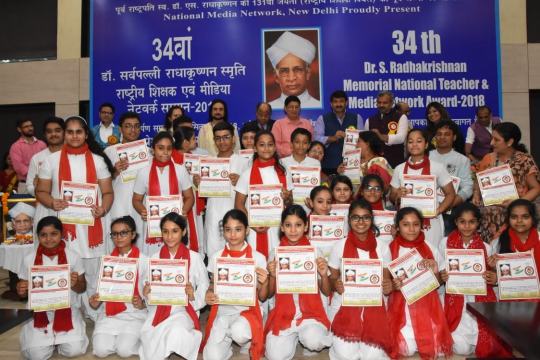
Distinguished personalities while hailing the role of Media and Educationist also urged them to play a more pivotal role in Nation Building by being ‘Role Models’ for the youth brigade.
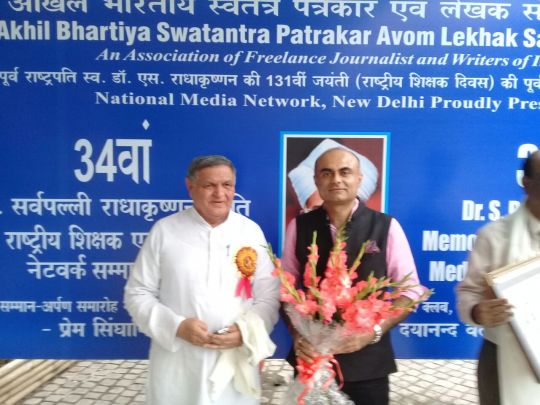
In his brief speech, Dr Yoganand Shastri said, “It is incredible that Akhil Bhartiya Swatantra Patrakar Avom Lekhak Sangh has been organizing and hosting the excellence awards in the field of education and media since the past 34 years. The distinctive aspect about their program being how they manage to introduce a novel component into these awards every year. Dr S. Radhakrishnan Memoral National Teacher’s and Media Network Award conferred on outstanding achievers by their organization has indeed been playing a crucial role in inspiring the brilliant achievers in various fields to scale even bigger heights. Educationists have a key role to play in the society which is why they are respected universally and remembered all their lives for their role in character building and holistic development. Teaching is unquestionably noblest of all professions.”
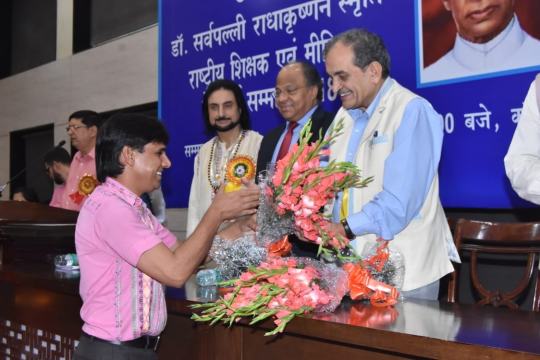
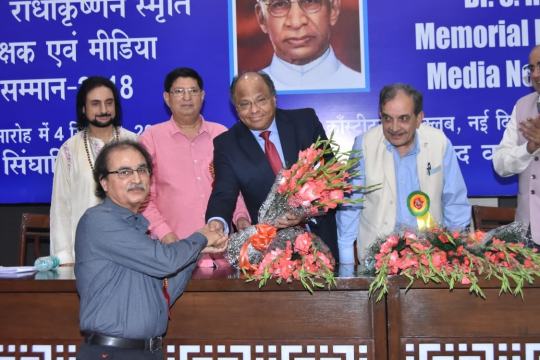
Feeling delighted with the honour, Sunita Vakil said, “Any award or honour is a recognition of the hard work and passion involved. Special gratitude to the jury that chose me to be one of the recipients of this special honour. The Award means a lot to me since it is an appreciation of my efforts.”
The awards ceremony was followed by tea and light snacks.
0 notes
Text
A Road Trip to Spiti Valley India - A Journey through Photos
Spiti Valley India
The Planning
The Itinerary
12 Day Spiti Valley India Itinerary
The Cast – A Guitarist, A Doctor, and a Writer
The Journey
Day 1 – Gandhidham to Ludhiana (Or so we thought)
We got on the train from Gandhidham to Ludhiana
At around 9 pm plans changed. We had a fully reserved train ticket to Ludhiana. But, the train was too slow. I found a train in the evening from Ajmer to Chandigarh which would get us to Chandigarh the morning after, our goal. And, it would also give us half a day to explore Ajmer and Pushkar. We got off at Ajmer at 6 am. My eyes fell on the train board – Ahmedabad-Chandigarh express was running late, approaching the platform in 5 minutes. If we could get on this we could reach Chandigarh by 5 pm, well ahead of our goal. We dashed to get tickets. We got General Class tickets and ran across four platforms just in time to make it.
Day 2 – A Journey in General Class, like a billion other Indians
Forget seats, you are lucky to find enough space for your bum, that too next to the bathroom. Traveling in General Class takes you right into the melee of true India. Highly recommend it. A quintessential Indian experience.
We reached Chandigarh on time. Rented a Mahindra Scorpio from ZoomCar right outside the train station and drove towards Shimla. Reached Shimla around 11 pm. Stocked up on supplies on the way.
Day 3 – Shimla to Reckong Peo (350 km, 8 hours)
The road to Reckong Peo passes through prime Kinnaur Valley.
Here at the edge of humanity, noble spirits turn alchemists to conjure triple-halo mountains, unicorns drinking at glacial waterfalls, mermaids swimming in the Satluj, snow fairies dancing amongst the flurries, fruits of passion growing on sub-earthly slopes and dragons breathing smiles
We reached Reckong Peo at sunset. We dined at Muskan Chinese Food Corner, a family run restaurant that was a popular choice of Imtiaz Ali and Randeep Hooda during the shoot of Highway around these parts. And, yes Reckong Peo is the location where Alia Bhatt gets off the bus in the movie. After dining on the ‘best’ vegetarian thukpa you could imagine, we went in search of the white mythical spirit of the mountains – Chang, a popular rice wine only available in these neck of woods. Its legality is controversial therefore tread carefully and ask locals to get your hands on a bottle of this snow-white spirit.
Day 4 – Reckong Peo to Pooh, a Date with the Deity
To see God himself in Kalpa, you must pass through what is well called ‘The Suicide Road’
“Adjust the zoom of your binoculars, you won’t believe your eyes since you’ve never seen God before. The Shivlinga of Lord Shiva meditating atop Mount Kinnaur Kailash, his winter home. The peak of Kinnaur Kailash is in the shape of a Shivalinga. Shivalinga belonging to Nataraja, the lord of the dances, performs the dance of the colors. It changes colors as the earth rotates on its axis. The Shivalinga attains the following colors – orange, yellow, saffron, crimson and hue – at different times of the day”
Kinnaur Kailash, Kinnaur Valley
A month ago at the doctor’s clinic, the Guitarist had asked: “Will we get to see snow?”.
Locals told us the road from Reckong Peo to Pooh is the deadliest road. So much so to raise our spirits. Onwards we go. Doc’s friend had told him after seeing his Instagram activity “The kind of sins you and the writer have committed, you not gonna survive these deadly roads. Fortunately, you have the Guitarist’s good deeds to protect you. Don’t use them all up”
At the crossroads after the bridge some 5 km before Pooh, sunset-lit mountain awaited us. The doctor said “Looking at these mountains you know what I feel like, I feel that someone up there is watching us and he wants us to complete our odyssey”
We survived the road and spent the night in Pooh weighing our sins and his deeds. So far so good.
Day 5 – Pooh to Tabo, Maybe
The Guitarist woke us all up to capture the first rays of sun falling on snow-capped peaks. We waited, waited, and guessed the direction of the rising sun to no avail. Frustrated, we went to bed after giving him an earful.
The hotel owner told us the road from Nako to Tabo is closed due to landslide at Maling Nala. We decided to continue until the road disappears.
The first rays of the rising sun kissed the zenith of the snowy peak as the melting snowy teardrops of the peak wiped the grey grief of the mountain
Sangam of rivers Spiti and Sutlej
Crossing the bridge is a metaphorically crossing into a different world of ancient monasteries, different language, unique culture, simple lifestyle, indigenous cuisine, and most notably stark barren landscape, a far shout from the green valleys of Kinnaur.
Welcome to Spiti Valley!
On reaching Nako village, the Doctor asked: “Where is the Nako Monastery?”
The Guitarist spotted a bat: “Hold on! Where can we play cricket?”
The kids pointed to the helipad
The Guitarist – “At such heights these people travel miles and miles to play cricket and bija aapda dukkar jeva friends badhu hoy chata pan na ave ramva” (and yet our f*ck*ng friends despite having everything don’t come to play)
After the game of cricket we went to the Nako Monastery. To our surprise and pleasure, the full moon celebration was going on. The villagers were chanting, meditating, and celebrating the full moon. We chatted with the locals in the monastery. They offered us lunch and we promptly agreed. I shared some of the snacks from back home. They absolutely loved it. A good idea to carry snacks from your town for the folks up there.
After dinner and a walk in Nako Village, we drove on. We stopped at the ear of the landslide. Another 2 hours and Maling Nala would open. The Guitarist went to observe the work going on. The Doc and I took a nap. When we woke up he was still not back. “Has he joined the army in clearing the landslide?” we said in unison.
He returned with a gleeful smile on his face, “I found three of them”. The smile transpired onto us. Stay tuned till The End.
We reached Tabo around dinner time.
Day 6 – Tabo Monastery
We visited the oldest Buddhist monastery in India – Tabo Monastery.
“It has seen a thousand flurries of snow, withstood a hundred thousand storms, it has sent a million messages of Buddha through the winds blowing south and east, a billion bells have been rung to send ‘Om mani padme hum’ into the valley, the prayer wheels have been spun countless times with timeless wishes. Yet, the monastery stands in simple mortar and cement telling the tales of a thousand years of the golden past and blessing the travelers who take the road less traveled to the parts clad in barren beauty”
Day 7 – Kaza, Key Monastery, and Apocalypse
“It is here more than anywhere else, I felt like I was on the path that Buddha mentioned 2,500 years ago “I teach suffering, its origin, cessation, and path. That’s all I teach”
After Key Monastery, we drove to Komic – the highest motorable village in Asia. On the top of the mountain, we encountered a snowstorm. Our car got stuck in the mud. What followed is a story to be told over camp-fires and spirits. It stretched us to our physical and mental limits as we know it. Probably the worst 24 hours my traveling life. We survived the trial by fire, thanks to the friendly locals of Langza village. Maybe doc’s friend was right, our sins caught up to us.
Day 8 – The Way Back
On our way back we visited Dhankar Monastery.
Dhankar Monastery
Sangam of Pin and Spiti rivers
On our way back we stopped by to pick them who the Guitarist had encountered at Maling Nala
Happy Endings
Memories of the Time Together
The Guitarist – “Going from traveling life to normal life is like going from 5,000 meters to sea-level”
12 Day Spiti Valley India Itinerary
A Road Trip to Spiti Valley India – A Journey through Photos was originally published on Winds of Travel
0 notes
Text
The prime worship of Lord Shiva is through the worship of Shiva Linga. Any other worship is secondary. The light of God “Jyoti Swarupa” exist in all the Shiva Linga forms. There are renowned 12 jyotirlingas across the world, each held with great esteem since the ancient times. Even the old Puranas glorify the abodes and talk in details about how devotees are pulled towards these kshetras due to the divine presence in these devodes.
What is jyotirlinga ?
A Jyotirlinga is a shrine where Lord Shiva is worshipped in the form of a Jyotirlingam. Now you would ask what a Jyotirlingam is? It is the radiant sign (phallus symbol) of The Almighty.
It is believed that Lord Shiva first manifested himself on Earth on the night of the Aridra Nakshatra, thus the special reverence for the Jyotirlinga. There is no unique appearance to mark the Jyotirlingas. Many people believe that you can see these lingas as columns of fire piercing through the earth after you reach a high level of spiritual attainment. Originally there were 64 Jyotirlingas out of which 12 are considered to be highly auspicious and holy.
Among the twelve Jyotirlingas, two are spread across the sea shore, three on the river banks, four in the heights of mountains and three in villages located in meadows. Anyone who goes to the temple receives the holy blessing of Lord and come back as happy, peaceful and blessed.
1. Somnath Jyotirlinga, Saurashtra, Gujarat
सौराष्ट्रे सोमनाथं च श्रीशैले मल्लिकार्जुनम्। Saurāṣṭre Somanāthaṃ ca Śrīśaile Mallikārjunam
Considered to be the first of the 12 Jyotirlingas, the Somnath Temple in Gujarat is situated near Veraval in (Prabhas Kshetra) Kathiawad district. One can find many references of this temple in the Puranas, as well as, the Itihas, “history”. Moreover, Somnath, also known as Prabhasa Kshetra, holds a much-esteemed place for Hindus. Back in the days, the inner temple was supported to be aglow with the lustre of gemstones, with Nanda Deep kept lighted with Kannauji attar. One can say, the temple was a treasure.
There is a legend related to how this Jyotirlinga came into being. According to the Shiva Purana, the moon was married to 27 daughters of Daksha Prajapati, out of which he loved Rohini the most. Seeing his negligence towards the other wives, Prajapati cursed moon that it would lose all its radiance. A disturbed moon along with Rohini came to Somnath and worshipped the Sparsa Lingam after which he was blessed by Shiva to regain his lost beauty and shine. On his request, Lord Shiva assumed the name Somchandra and resided there eternally.
This is also considered to be the primary of all the JyotirLingas as it is considered to be Swayambhu (self-birth) and is always awake with hundreds of thousands of devotees visiting the temple every year.
2. Mallikarjuna Jyotirlinga, Srisailam, Andhra Pradesh
Built around 1234 AD by the Hoyasala king, Vira Narsimha, Sri Mallikarjuna Jyotirlinga is located in Kurnool district of Andhra Pradesh, an area full of forests of Kadali, Bilva trees, mountain ranges and Patalaganga (Krishnaveni river). This river is in the form of underground spring, and this is where millions of devotees take the holy dip and go to worship the Jyotirlinga.
It is also known as “Kailash of the South” and is one of the greatest Shaivite shrines in India. The presiding deities at this temple are Mallikarjuna (Shiva) and Bhramaramba (Devi).
According to the Shiva Purana, Lord Ganesha was married off before Kartikeya which left Kartikeya angered. He went away to the Kraunch Mountain. All the Gods tried to console him but in vain. Ultimately Shiva-Parvati themselves travelled to the mountain but were turned away by Kartikeya. Seeing their son in such a state they were very hurt and Shiva assumed the form of a Jyotirlinga and resided on the mountain by the name of Mallikarujna. Mallika means Parvati, while Arjuna is another name of Shiva. It is believed by the people that just seeing the tip of this mountain one is emancipated of all sins and becomes free from the vicious cycle of life and death.
History recounts when Chatrapati Shivaji used to take a “Darshan” of the JyotirLinga during the Maharatri, and he also built a tower on the right side of the temple, opening a free meal center. Other kings of Vijayangar Dynasty have built the temple, tower, portico, and a pond too. Before it was difficult to reach because of terrain, yet many devotees have reached there with their sheer will-power. This includes the mythological personalities like Hiranyakashipa, Narada, Pandavas, Sri Ram.
3. Mahakaleshwar Jyotirlinga, Ujjain, Madhya Pradesh
उज्जयिन्यां महाकालमोङ्कारममलेश्वरम्॥ Ujjayinyāṃ Mahākālam Omkāram Mamleśhwaram
This temple lies in the city of Indrapuri Amaravati and Avantika, known as the “Swarna Sringa” because of the number of golden towers of several temples in the city. Mahakaleswar is grand and is also known for the foundation of Adyapeetha, the foundation of Sanskrit learning, ethics, knowledge or science, and art. It is said that those who visit Mahakal temple will never be touched by sorrows, even in the dreams, and those who pray to the Mahakal would be granted all the wishes.
According to the Puranas, there was a five-year-old boy Shrikar who was enthralled by the devotion of King Chandrasena of Ujjain towards Lord Shiva. Shrikar took a stone and started worshipping as Shiva. Many people tried to dissuade him in different ways, but his devotion kept growing. Pleased by his devotion, Lord Shiva assumed the form of a Jyotirlinga and resided in the Mahakal forest.
The other mythological stories which is most frequently heard is that Lord Shiva appeared in Ujjain from the ground to vanquish a demon called Dushana whose tortures on the people and Brahmins of the Ujjain city, had crossed all the limits. After killing the demon, Lord Shiva took the form of Jyotirlinga and since then, he has been residing in this holy city
4. Omkareshwar Jyotirlinga, Shivapuri
The word Omkareshwar means “Lord of Omkaara” or the Lord of the Om Sound!
सप्तजन्मकृतं पापं स्मरणेन विनश्यति॥ saptajanmakṛtaṃ pāpaṃ smaraṇena vinaśyati
This temple is self-born and thus is known as Swayambhu linga. Across the mountain range of Madhya Pradesh, river Narmada flows rippling from the mountains where smooth, round pebbles, known as BanaLingas, are found. On the bank of the river, this temple lies in a huge island.
The island and the river themselves are shaped like “Om” naturally. Devotees feel blessed when they go to the temple as they are doing the parikrama of Om themselves when they visit the temple.
Once upon a time there ensued a great war between the Devas and Danavas (Gods and Demons), in which the Danavas won. This was a major setback for the Devas who then prayed to Lord Shiva. Pleased with their prayer, Lord Shiva emerged in the form of Omkareshwar Jyotirlinga and defeated the Danavas
5. Vaidyanath Jyotirlinga, Deogarh, Jharkhand
परल्यां वैद्यनाथं च डाकिन्यां भीमशङ्करम्। Paraly Vaidyanāthaṃ cha Ḍākinyāṃ Bhīmaśhaṅkaram
It is located in Deoghar in the Santhal Parganas division of the state of Jharkhand, India. According to Shiva Mahapuran, the location is identified as “Chidabhoomi”, which could be the ancient name of Deoghar, and there are references to “Baidyanatham chitabhoomau”. The place also celebrates Krishna festival, despite being a Shiva temple. It is built with stones on a high mound and is surrounded by strong walls on all four sides. Special prayers are held for Sun God in the temple, as the sun rays falling through the windows shine directly on the Lingamurthy inside.
According to a famous legend, the demon king Ravana meditated and asked Lord Shiva to come over to Sri Lanka and make it invincible. Ravana tried to take Mount Kailash with him, but Lord Shiva crushed it. Ravana asked for penance and in turn was given of the twelve Jyotirlingas on the condition that if it was placed on the ground it would remain rooted to that spot till eternity. While transporting it to Sri Lanka, Lord Varuna entered Ravana’s body and he felt an urgent need to relieve himself. Lord Vishnu came down in the form of a lad and offered to hold the lingam in the meantime. However, Vishnu placed the lingam on the ground and it got rooted to the spot. As a form of penance, Ravana cut off nine of his heads. Shiva revived him and joined the heads to the body, like a vaidya and hence this Jyotirlinga came to be known as Vaidyanath.
6. Nageshvara Jyotirlinga, Darukavanam (Aunda)
एतेशां दर्शनादेव पातकं नैव तिष्ठति। eteśāṃ darśanādeva pātakaṃ naiva tiṣṭhati
Legend has it that Pandavas came during their Banbas and built a hermitage for themselves at this place. Legends aside, the architectural beauty of Naganath Temple is exquisite. The structure is beautiful too. Built with stones, the temple is oval shaped and is protected with walls around four sides. The Nandi temple is separate from the main temple, however. All in all, 108 Shiva temples and 68 shrines are located around the temple. Also Read : This Vishnu temple in Kerala is the richest temple in the world. Every 12 years, devotees offer Kashi Ganga as Padarpan at the time of Kapila Shashti.
According to the Shiva Purana, a Shiva devotee by the name Supriya was captured by the demon Daaruka. The demon imprisoned her with several others in his capital Daarukavana. Supriya advised all prisoners to chant “Aum Namaha Shivaya” which enraged Daaruka who ran to kill Supriya. Lord Shiva manifested in front of the demon and put an end to him. Thus the Nageshwar Jyotirlinga came into being.
7. Kedareshwar Jyotirlinga, Kedarnath, Himalayas
हिमालये तु केदारं घुश्मेशं च शिवालये॥ Himālaye tu Kedāraṃ Ghuśmeśaṃ ca Śivālaye
This temple is located at the snow-covered area of Himalayas. One can only visit this temple during six months of a year, the rest of the month, the snow, and extreme cold do not permit devotees to enter. As such, the Kedarnath temple remains closed for pilgrims. Due to extreme snowfall of Kartik, the Sri Kedarshwar idol is brought out of the temple after lighting a ghee lamp, “Nanda Deepa” and the temple is closed for the winter. This idol is shifted to the Urvi Math, in the valley. The temple only opens later in Baisakh. People visit here to see the Nanda Deepa, and when they see this, they consider themselves to be blessed.
According to the legends, pleased by the severe penance of the Nara and Narayana – two incarnations of Lord Vishnu, Lord Shiva took up permanent abode in Kedarnath in the form of this Jyotirlinga.
8. Trimbakeshwar Jyotirlinga, Nashik
एतानि ज्योतिर्लिङ्गानि सायं प्रातः पठेन्नरः। etāni jyotirliṅgāni sāyaṃ prātaḥ paṭhennaraḥ
Tryambakeshwar Temple lies on the banks of Gautami, near Nashik in Maharashtra. Unlike other temples, the Lord in the temple’s Grabhagriha is not worshiped with Abhisekha with water (Jalahari). Instead, there is a bottom part of pounding stone, like a hole, where three Lingas shaped like thumbs exist (hence, the name Tryambakeshwara). An orifice above one of the Linga has a constant shower of water, and this is the Linga of Mahesha.
Every 12 years, Kumbhmela is held here at the time of Simhasta. The architecture is beautiful too with beautiful statues carved around the premise.
Gautam Rishi earned a boon from Varuna in the form of a pit from which he received an inexhaustible supply of grains and food. The other Gods were rendered jealous by him and they send a cow to enter the granary. The cow was mistakenly killed by Gautam Rishi who then asked Lord Shiva to do something to purify the premises. Shiva asked Ganga to flow through the land to make it pure. Everyone thus sang praise for the Lord who then resided beside Ganga in the form of Trimbakeshwar Jyotirlinga.
Read more about this here
9. Rameshwar Jyotirlinga, Rameshwaram
सेतुबन्धे तु रामेशं नागेशं दारुकावने॥ Setubandhe tu Rāmeśaṃ Nāgeśhaṃ Dārukāvane
This temple is situated on a big island of sand, in the Ramnad district of Tamilnadu. Today, it has been expanded into a large temple and is famous for its typical architecture. One finds it auspicious and pious to take Ganga water to this temple after the pilgrimage of four holy shrines. The ritual goes like this: the person takes holy bath in the Ganga river, takes the Ganga water to the temple and offered to Lord Shiva of Rameshwaram, a sanga from there is then carried to Ganga and immersed there. This makes the ritual complete. A grand Badatra mela/fete is organized on the 15th day of Ashada and during Mahashivaratri.
This Jyotirlinga is closely associated with Ramayana and Ram’s victorious return from Sri Lanka. It is believed that Ram on his way to Sri Lanka stopped at Rameshwaram and was drinking water on the seashore when there was a celestial proclamation: “You are drinking water without worshipping me.” Listening to this Ram made a linga of sand and worshipped it and asked for its blessings to defeat Ravana. He got the blessings from Lord Shiva who then turned into a Jyotirlinga and resided at the place for eternity.
10. Bhimashankar Jyotirlinga, Dakini, Maharashtra
कर्मक्षयो भवेत्तस्य यस्य तुष्टो महेश्वराः॥: karmakṣayo bhavettasya yasya tuṣṭo maheśvarāḥ
The temple of Bhimashankar is built in Hemadpanthi style, embellished with Dashavatar statues, qualities that make the temple very beautiful to look at. One enjoyable thing to do in this temple is the ring the big bell and hear the echo roaming the entire temple. Every day, people worship Bhimashankar with Rudrabhishek, Panchamrit snan. The temple is flooded during Mondays and during the Mahashivaratri. Along with the temple, the natural scenic beauty of the temple is wonderful to look at. Moreover, when one enters the River Chandrabhaga (Bhima) on the expansive meadows, one can see a large number of devotees dancing together in a trance.
The legend about the existence of this Jyotirlinga is related to Kumbhakarna’s son Bhima. When Bhima learned that he was the son of Kumbhakarana who was annihilated by Lord Vishnu in his incarnation as Lord Ram, he vowed to avenge Lord Vishnu. He performed penance to please Lord Brahma who granted him immense power. On achieving this power, he started creating havoc in the world. He defeated the staunch devotee of Lord Shiva- Kamrupeshwar and put him in the dungeons. This angered the Lords who requested Shiva to descend Earth and put an end to this tyranny. A war ensued between the two and Shiva ultimately put the demon to ashes. All the Gods then requested Shiva to make that place his abode. Shiva then manifested himself in the form of Bhimashankar Jyotirlinga. It is believed that the sweat which poured from Shiva’s body after the battle is what formed the Bhima River.
11. Visweswar Jyotirlinga, Varanasi, Uttar Pradesh
वाराणस्यां तु विश्वेशं त्र्यम्बकं गौतमीतटे। Vārāṇasyāṃ tu Viśveśaṃ Tryambakaṃ Gautamītaṭe
In the ancient times, Varanasi used to be a beautiful city built in the adjoint of Varana and Asi. This is where kasha, a tribe, used to live, and thus, Varanasi was also known as Kashi. The Ganga here flows in the shape of a bow, and thus there is a special importance for this area and its temple Kashi Visweshwar.
According to Puranas, this city used to be ruled by Brahma, Vishnu, and Mahesha, and this is where even divines want to tie. The present temple we see today was built by Ahalya Devi Holkar in 1777 AD and has the towers covered in gold (as planted by King Ranjit Singh).
12. Grishneswar Jyotirlinga, Devasrovar, Maharashtra
As Madhwamunishwar once said, “Blessed by VerulNagar, there is no other place like it on this earth, where Lord Grishneswara resides, the best place on this earth.”
This last place of the Jyotirlinga, without which the pilgrimage will not be complete, lies in the village of Verul.
According to the Shiva Purana, a couple named Sudharm and Sudeha resided on the Devagiri Mountain. They were childless, and thus Sudeha got her sister Ghushma married to Sudharm. They bore a son who rendered Ghushma proud and Sudeha jealous of her sister. In her jealousy, Sudeha threw the son in the lake where Ghushma used to discharge 101 lingams. Ghushma prayed to Lord Shiva who ultimately returned her the son and told her of her sister’s deeds. Sudharm asked Shiva to emancipate Sudeha which left Shiva pleased with his generosity. On Sudharm’s request, Shiva manifested himself in the form of the Jyotirlinga and assumed the name Ghushmeshwar.
Later Bhosala, very devout Shiva devotee, once found a treasure hidden in the snake pit by the grace of Lord Grishneshwar. As a return, he spent the money to renovate the temple and even built a lake in Shikharshinganapur. Later, Goutamibal and Ahilyadevi renovated the temple. Today, it stands at 240ft X 185 ft, strong and beautiful.
As mentioned in each of the Jyotirlinga, if a person prays those Dwadasa JyotirlInga Strotam during the pilgrimage at each temple, then he will attain salvation and enlightenment, and after death will be released from the cycle of human existence. Worshipping the Lingas will also free people from difficulties and struggle. Darkness eats people and kills them with ignorance.
Jyotirlingas, with its Jyoti “light”, frees people from darkness and the natured light of God fulfills all our wishes
12 Holy Jyotirlinga Temples of Lord Shiva The prime worship of Lord Shiva is through the worship of Shiva Linga. Any other worship is secondary.
0 notes
Text
Theory on the guardian Temple: Mount Kailash
Every since "The Collector" I was convinced that the guardian mountain in Miraculous is most likely inspired by a real life counterpart. Then "Feast" came around and confirmed it to me. So I started to do some research and here we are with my answer and a new theory: Mount Kailash.
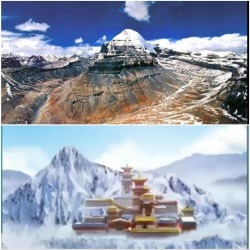
This mountain is surrounded by mysteries GALORE and its was such an interesting research to do! The more I read up on it the more I was convinced that this is indeed the inspiration of the guardian mountain in Tibet (and its entire society) we see in the show.
So let's not waste any more time and let's dive in. As always, I have alot to say ^^
As always, starting with the basics:
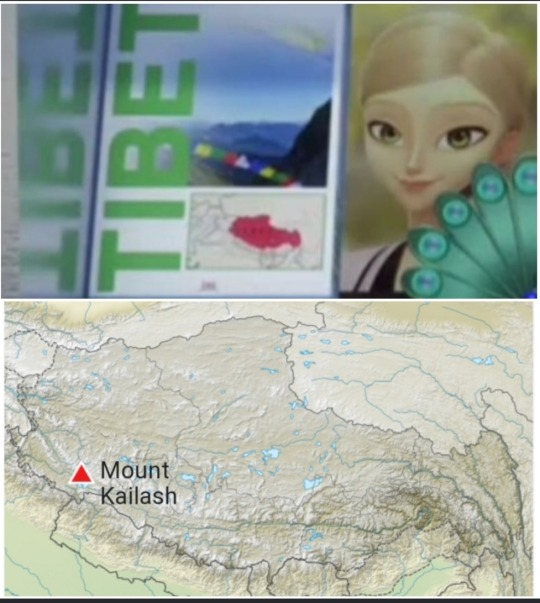
Just like in the show, Mount Kailash is located in Tibet and is part of the Himalaya. Its shape is a bit tricky to compare but even if it wouldn’t add up I think it wouldn’t matter that much. As long as the Ml mountains shape isn’t completely off and unrecognizable let a mountain be a mountain, the shape is not what’s most important about it anyway (not in this theory at least). The height on the other hand adds up very nicely. As we see in the flashbacks the guardian mountain may have been up high but also wasn't the highest mountain in the region by far.
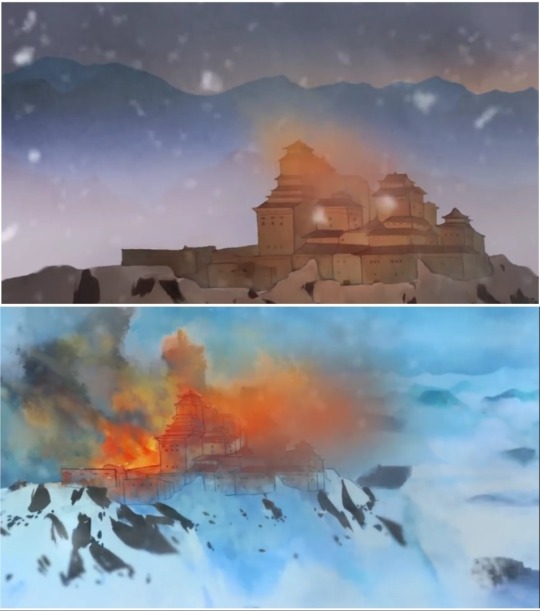
This also applies to Mount Kailash. It is “only” 6,638 m (21,778 ft) high, which is small in comparison to several other mountains that go up to 8,850 metres (29,035 ft). So just like in the show, its not the highest mountain but definitely high enough to sometimes be above a cloud layer.

Next is the lake. Just like we saw in Fu’s flashback, mount Kailash also has a lake. Two to be correct. Lake Manasarovar and Lake Rakshastal.
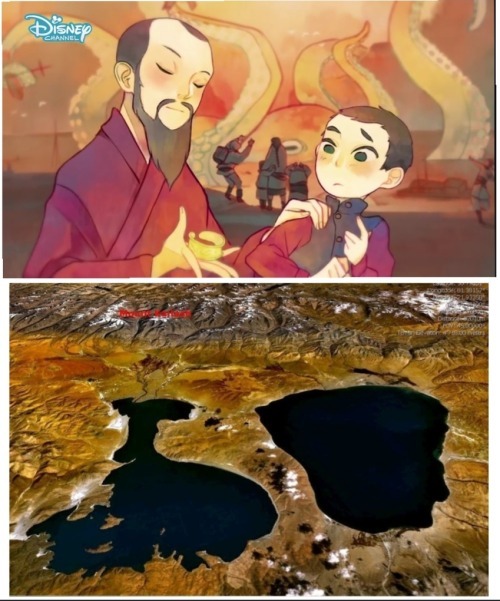
The lake seen in the flashback I believe to be Lake Manasarovar (right)
The lake is located right by Mount Kailash and is believed to be the most sacred one in Tibet and has the most transparent water among all the lakes in China. In Hinduism, Lake Manasarovar is a personification of purity and bathing in it and drinking its water is believed to cleanse all sins. That sounds definitely like a perfect fit for the ancient, mystical guardian mountain lake we are looking for here.
Of course, the show hasn’t given us any indications yet that the mountain lake has such a high status (how could it? We saw it in one picture) and for all it is, the one in the show doesn’t have to. If the lake(s) end up having such qualities as well (which I believe and I’m also convinced the second lake will be of great importance as well but all of this is an extended theory for a very different day) than that’s wonderful and I’m more than happy, but if not then I’m convinced as well that it was not just a random lake they put in there but one with a mighty cultural significance.
Beside that, the lake happens to be a fresh water lake. This would also explain how a squid or kraken was shown to us to have been there, since those are freshwater animals.
Next is the whole temple thing in general. In real life there is of course no temple on Mount Kailash, but this doesn't mean that the concept of a temple for this mountain is anything new. In fact, it's really, totally, utterly not. There may be no temple on our mountain but we still do have a Kailasa temple and MY is this one important as well!
Comparing these two makes it quite obvious right away, they do have big differences. The material, the design etc. But once again, inspiration doesn't mean copy paste.

What caught my attention here were for example the big stone circle in the middle that mirrors the guardian symbol and the big tower right beside it reminds of the biggest building from the guardian temple. While the Kailasa temple is not built on Kailash, it's shape is supposed to reflect and honor the mountain because the temple was built for the greatest of the hindu gods, lord Shiva (the main God who is supposed to life on top of kailash's peak) and therefore it was supposed to resemble his home.
Meaning what Miraculous did here in my opinion, is that they simply combined Mount kailash and the Kailasa temple to make their own version for the show that is unique enough to stand on its own but also stays close enough to its roots to properly honor and portray them.
I LOVE this.
(Okay I'm gonna take this little section to gush a little about this temple because my GOSH this temple is a beauty to behold!
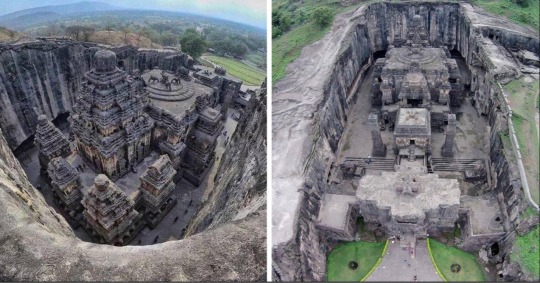
You are not just looking at any temple here, all of this was CARVED out of the stonewall in ONE PIECE! This is one of the greatest architectural masterpieces in human history and today no one can actually tell how the ancient local people even DID this.

I mean LOOK at this! This is of pure stone, all in one piece and there is even a gigantic underground section!
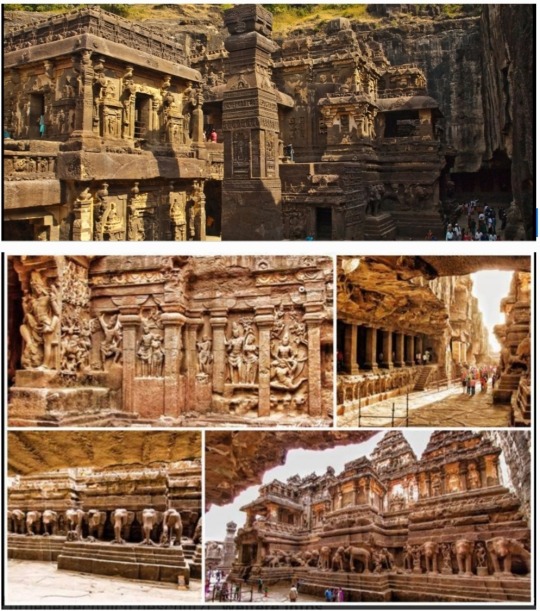
And each and every wall is full of smaller carvings from the bottom to the top, telling the stories of their culture, their mythology and believes. And even those are little pieces of art for themselves! This is marvellous! I hope that one day I will be able to see this place in person because... wow!)
Alright, leaving the materialistic basics behind us, lets take a look at its religious and cultural significance and its mystical reputation because those are *chef kiss* just beautiful.
Here is an important thing to keep in mind that since the Miraculous mountain is not going to be straight up real life Kailash, only inspired by it, this also means the show would be able to include some of its myths and folklores a lot more directly. Therefore I’m also including them here in my theory.
Coming back to what I said earlier, that apparently Mount Kailash is the holiest mountain on earth. And well, that's no exaggeration of mine. Mount Kailash is the center point of 4(!) religions, Buddhist, Hindu, Jain and Tibetan Bön. These religions also make the fact that the guardians are portrayed as monks a perfect fit. The fact that Mount Kailash has such an immense significance for the regional religions also led to one of the greatest check points for this theory:
Mount Kailash is to this day unclimbed. For several reasons I will cut down to the 3 most important for my theory:
1. As Mount Kailash is believed by 4 religions to be the center point/or a place of great significance, it is also a place that people hold in alot of honor, respect and fear as well. It's peak is believed to be place were their gods rest and/or where basically the divine energies of Existence are residing and therefore you don't just CLIMB that mountain.
Regional people and believers go an incredibly long way to honor it even to this day and therefore, no, regional people never dared to claim this mountain for themselves and its forbidden by the law to dishonor this sacred place by doing so. Bringing this back to miraculous I’m sure you already see why this fits like a glove.
If there is any real life mystical mountain the guardians of the miraculous would be located on, it's this one! The Miraculous are the origins of the in-universe world and as we know from Fu it is an unspeakable honor to be chosen as one of their guardians. The guardian society was/is located off of the normal society and at least the local people from Fu's childhood knew of their existence. Meaning here again, the miraculous mountain as well holds a great cultural significance and only the chosen guardians were allowed to climb it but for that they also had to dedicate their lives to the miraculous and life in isolation from the rest of the world.
This in combination with:
2. When I say it is forbidden to climb that mountain I mean FORBIDDEN. Not only by regionals and believers because of religion reasons. No. Between the 50s and the 70s Chinese authorities have officially managed to declare this sacred mountain as off limits, keeping it unclimbed and under protection with all means needed. Meaning no climbing by foot (beyond the free area that has always been allowed) or by any machine. It's peak is to be remained untouched. And this also means any footage taken from the mountain needs to be done from far away, no matter how ouf of the world the happening on the mountain may be. And that's precisely what we saw in "Feast"

One would think that the reappearance of a long-lost temple on a fuck high mountain would get the immediate reaction of storming and exploring it like hell. But that's not what's happening here and I don't think it's just for plot convenience at all. If we are indeed talking about a mountain in miraculous here that is just as protected by the law as mount Kailash in real life, then THIS reporting here is as close as anyone can officially/legally get in that moment without serious consequences with the law and Chinese government.
They didn't NOT storm the temple because of plot reasons, they didn't because they are legally aren't allowed to set foot on a sacred unclimbed mountain that is supposed to stay that way. What a great and subtle way of telling us more and more about the significance of the guardian mountain. Wonderful Miraculous, I applause you ^^
But there is still another reason why Mount kailash's unclimbed status convinced me that this is indeed the mountain we are (at least in an inspired way) being presented with in the show.
My point 3. is the reason why Kailash remained unclimbed by (the native) people in the first place which highly influenced its immense religious status although history to the point where it is believed to be the center place of GODS, THE ENTIRE UNIVERSE and ALL OF EXISTENCE.
Cause its not like no one ever tried to climb it. Naturally people did, just like with any other mountain on earth. But here is the thing: somehow no one was able to actually DO it. Odd how humans were and are able to reach the peak of freaking Mount Everest even though it's ALOT higher and objectively deadlier by a long shot but "small" and "easy" Kailash is the one still unclimbed.
Kailash didn't get its godly, mystical and fear-striking reputation for no reason. We are now officially stepping into folklore and myth terrain which is actually exactly what we are looking for because a show called "Miraculous" is going to REGALE in the supernatural stories of its influences. And when I say supernatural, I do indeed mean SUPERNATURAL. The climbers who survived their trip reported of unearthly happenings and situations that made claiming Kailash simply impossible. I'm not sure if saying Kailash seems to have a mind on its own is appropriate but it surely seems to try to defend itself from people who aren't worthy or not supposed to be there with means from another layer of existence.
Sudden weather extremes that come out of nowhere to stop the mountaineering and a seemingly changing environment that leads the climbers into confusion, the wrong direction (away from the peak) and even their end are two of the greatest examples and they fit perfectly into the nature of the Miraculous.
Another myth I’ve read quite a lot about is that on Mount Kailash time works… differently.
This also goes back to its defence mechanism of intruders because it is said that trying to climb it will let hair, nails etc grow a lot faster or fasten up the aging process all together to the point were relatively young climbers died the very next year of freaking OLD AGE! This is not only interesting for the miraculous mountain because it’s a supernatural coping mechanism of the Miraculous origin place using a power we are already familiar with (Bunnix time powers) but also because Kailash’s very same time anomalies are also said to grand a longer life (to those who are worthy if I’m not wrong). And do tell, what’s Fu’s age again? That’s right, a very impossible 186.
BUT, when the Miraculous guardian mountain does grand those who are chosen to be guardian (probably through a ritual or something like that to ultimately seal their “decision” to dedicate their lives to the Miraculous) a much longer life through its magical nature, that would definitely make Fu’s age much more plausible.
And yet still, even after everything I brought up one can still raises the questions “Yes but why THIS mountain? What’s so special about it that all of the miraculous things would happen there? Real-life and Miraculous. For all it is, is it just a coincidence?”
You all know me well enough by now that NOPE, I’m sure as heck not done yet :D Lets get to my last point and this one is what sold this entire idea to me 100%, without a single doubt left behind. This is the HEART of this theory.
Let me explain to you Mount Kailash’s status as Axis Mundi.
Trying to keep this as easy as possible, I do think its concept is comparable to the medieval believe that the earth is the centre of the universe. That everything from the sun to every known planet circles around us and we were the first and most important thing created. Axis Mundi is somewhat like this.
Axis Mundi means “earth axis” in latin and is basically the center point of the earth. It has several ways to approach its meaning from religion, astrology to geography. Good thing for us, Mount Kailash is a complete jackpot in this regard, so this makes it easy! (This is probably the reason why Kailash is seen as THE Axis Mundi for many people, even if there are several others that fit under certain categories as well)
Astrologically Mount Kailash is an Axis Mundi because of its location between the two celestial poles. Its distance to the north pole is 6666km and to the south pole LITERALLY the double: 13332km. Its wild, but it gets even better!
The geographical point of view only supports the astrological because Mount Kailash is said to be part of a several-linked-monuments-line with the exact same km-count of 6666km in between all of them.
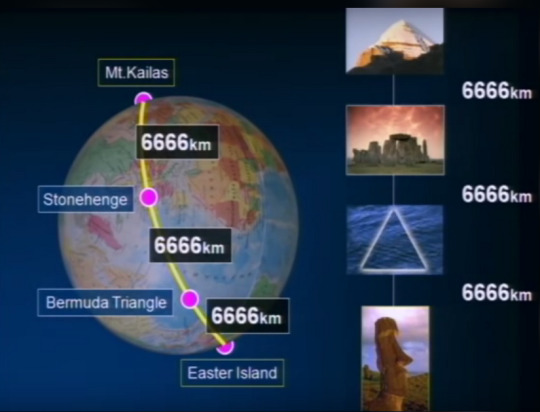
And maybe this is the right time to remind you that the height of Mount Kailash that I have mentioned in the beginning is 6638m.
Although this is a point, I wouldn’t bet my hand on for 100% legitimacy, since when I double checked the Kailash to Stonehenge UK distance on Google Earth, I ended up with a distance of 6.900-something km. But at the same time the measurement system there can get quite off in such mountainy terrains so that doesn’t mean its officially wrong. Just in question. Luckily it isn’t even that important if this is true or not in real-life, because even if it isn’t, then Miraculous as a TV show can still incorporate and work with this myth/conspiracy(?) no problem.
Another geographical but more local reason for why Kailash is seen as Axis Mundi in China is because there 4 main Asian rivers find their source: Shiquan (Lion!) river, Maquan (Horse!!) river, Xiangquan (Elephant) river and Kongqu (Peacock!!!) river. now that’s something to keep in mind in future. Each on one of the 4 sides of the mountain, making it indeed a source of life for all of China and therefore a “center point” as well.
And last but definitely not least and my, this one if my favourite!
As I explained earlier, Mount Kailash is seen by 4 religions as the center place of their gods, the entire universe and all of creation. But not only that. Because since it is the place where literal gods can manifest, it is also the place where our material world meets the spiritual one and they overlap (Hence the supernatural nature and abilities of the mountain).
Do you see what this means for Miraculous?
It means that the guardians didn’t chose their mountain by sheer coincidence. It means that this very mountain peak is the place where humans where/ARE able to get access to the Kwamis!
A while ago Thomas Astruc posted this on Twitter
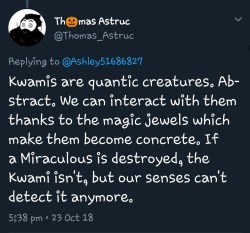
He describes the nature of the Kwamis as not actual living creatures per se but more like the embodiments of abstract concepts found in this universe’s existence. Humans can only interact with them through the ml jewelleries but even if these get destroyed (bee miraculous in “Queen Wasp”) the Kwami doesn’t “die”, it just goes back to its original abstract (bodyless) form and can be brought back with their Miraculous because, logically, destroying the bee miraculous for example didn’t wipe out the entire concept of Submission. Duh. Therefore, Pollen was still “there”.
So if the Kwamis are more embodiments of abstract concepts which need a specific item to physically materialize in the, well, MATERIAL world then this means there needed to be a place of transition between these two layers of reality to seal the Kwamis to the Miraculous’ in the first place. And BOY, this is it!
I’m so convinced that the guardian mountain is the Miraculous inequivalent of our Mount Kailash, everything fits like a glove and explains so many questions I haven’t even considered to ask before now!
Especially the last part about the origins and nature of the Kwamis and how their transition into the real world happened is such a gigantic lore aspect! There is so much to be discovered and connected here and I’m already reworking everything about the lore I have so far and MAN I’m glad I picked up on theorizing about Ml again! I am EXCITED!
But for now, this is it :D
#miraculous#miraculous ladybug#ml theory#guardians of the miraculous#ml tibet#kwamis#ml spoilers#ml feast#ml season 3#ml guardian mountain#Mount Kailash#Kaisala temple#ml master fu#ml sugar
238 notes
·
View notes
Text
СВЯТОЙ ГОРЕ КАЙЛАШ ВИА ЛАСА-НРИ СПЕЦИАЛЬНЫЙ
СВЯТОЙ ГОРЕ КАЙЛАШ ВИА ЛАСА-НРИ СПЕЦИАЛЬНЫЙ
Код тура Название тура Продолжительность Назначение FML-NRI 500 A Святая гора Кайлаш через тур по Лхасе 11 ночей / 12 дней Лхаса, Шигадзе и Святая гора Кайлаш и озеро Мансаровар План маршрута: День 01: Прибытие в Лхаса и Трансфер в отель День 02: достопримечательности вокруг города Лхаса, День 03: Поездка из Лхаса в Шигадзе, День 04: Поездка из Шигадзе в Сага, День 05: Поездка из Саги в…
View On WordPress
0 notes